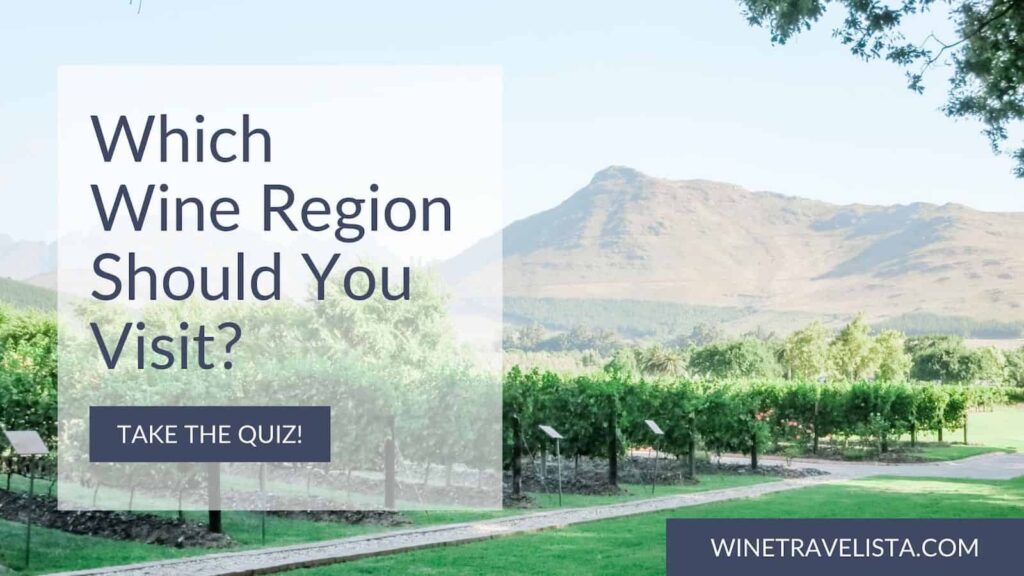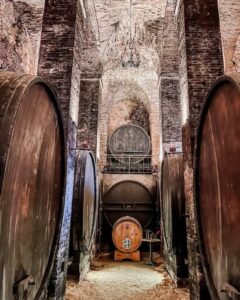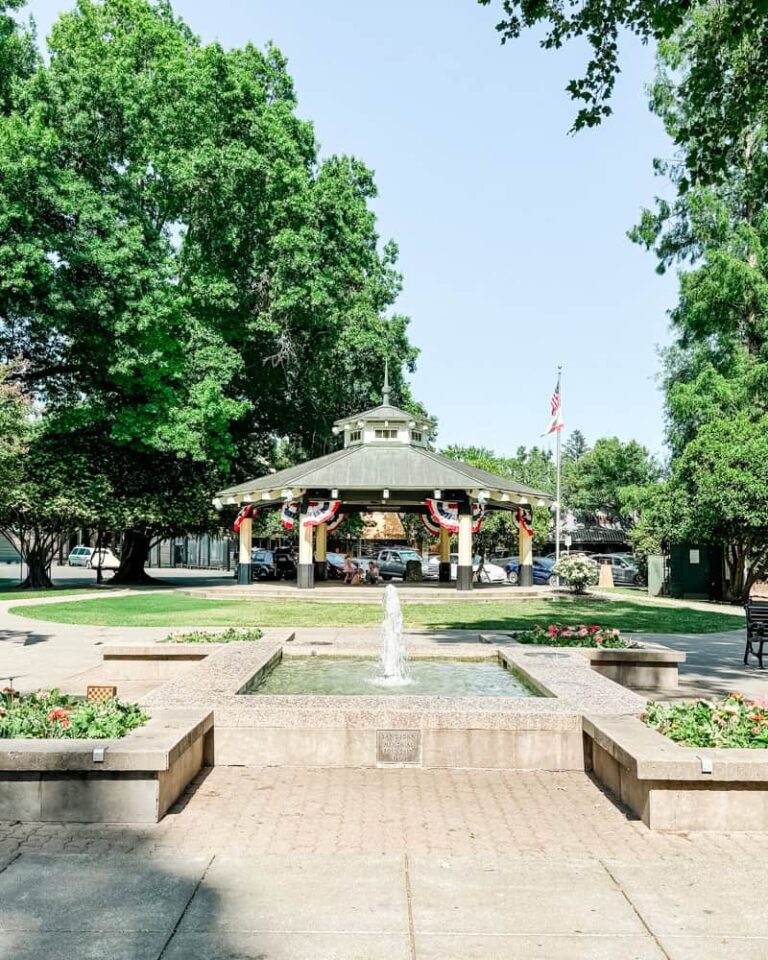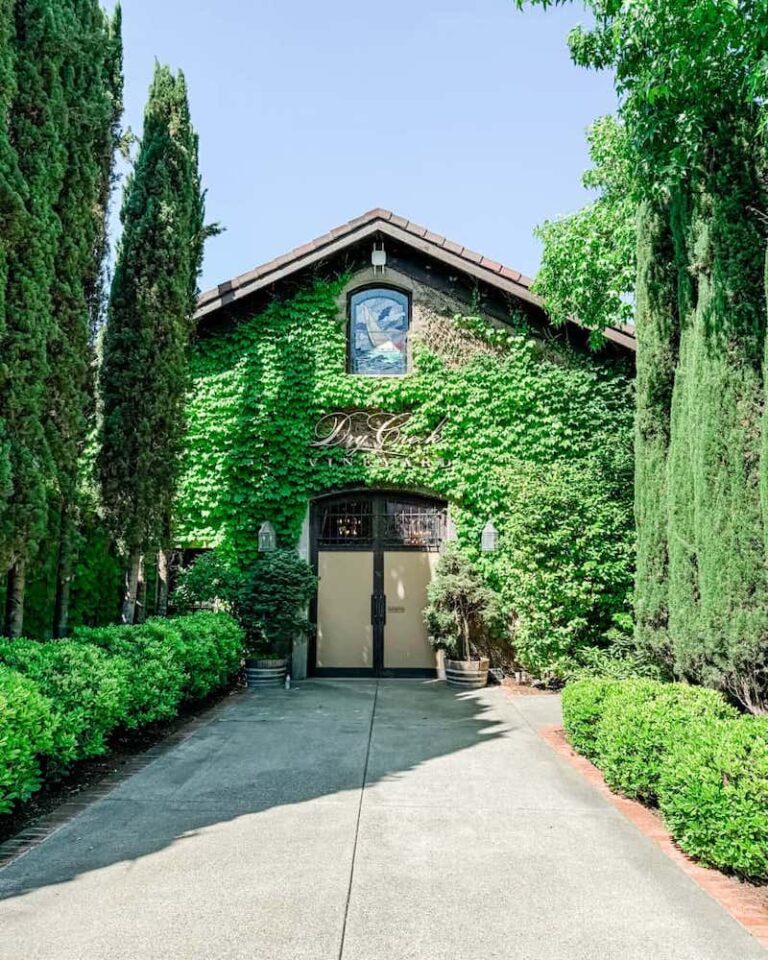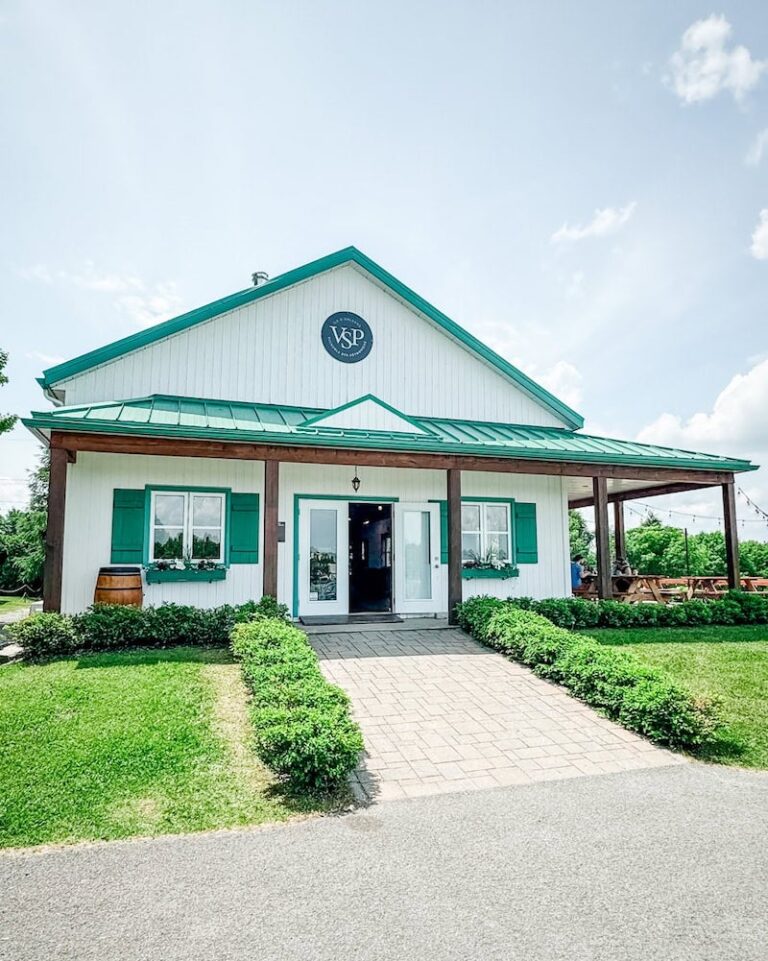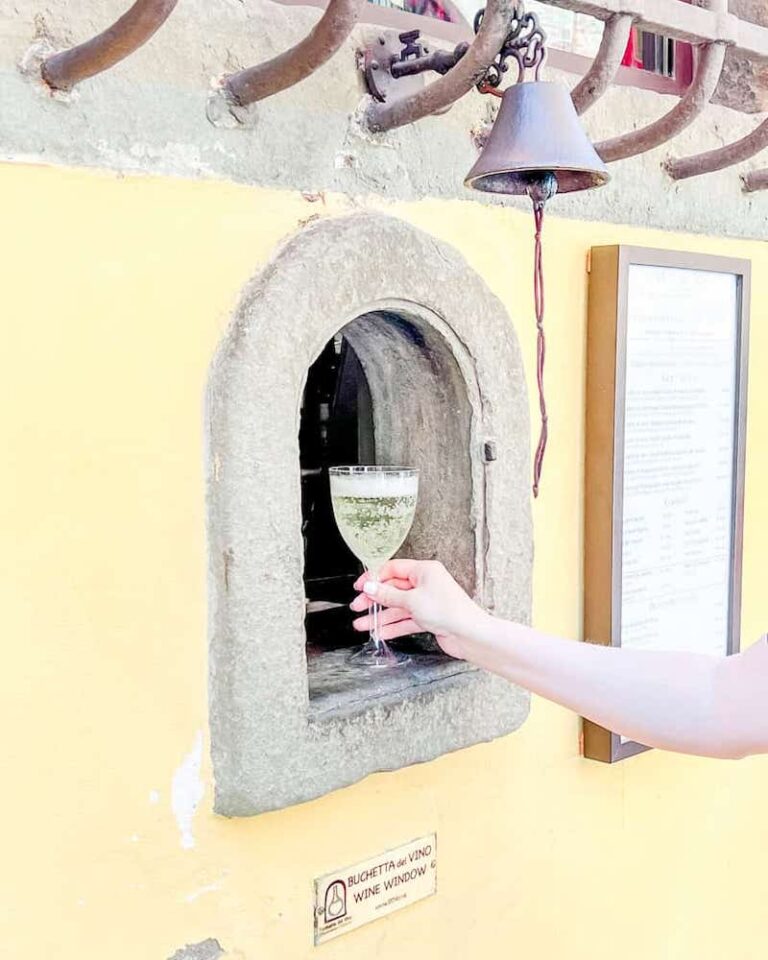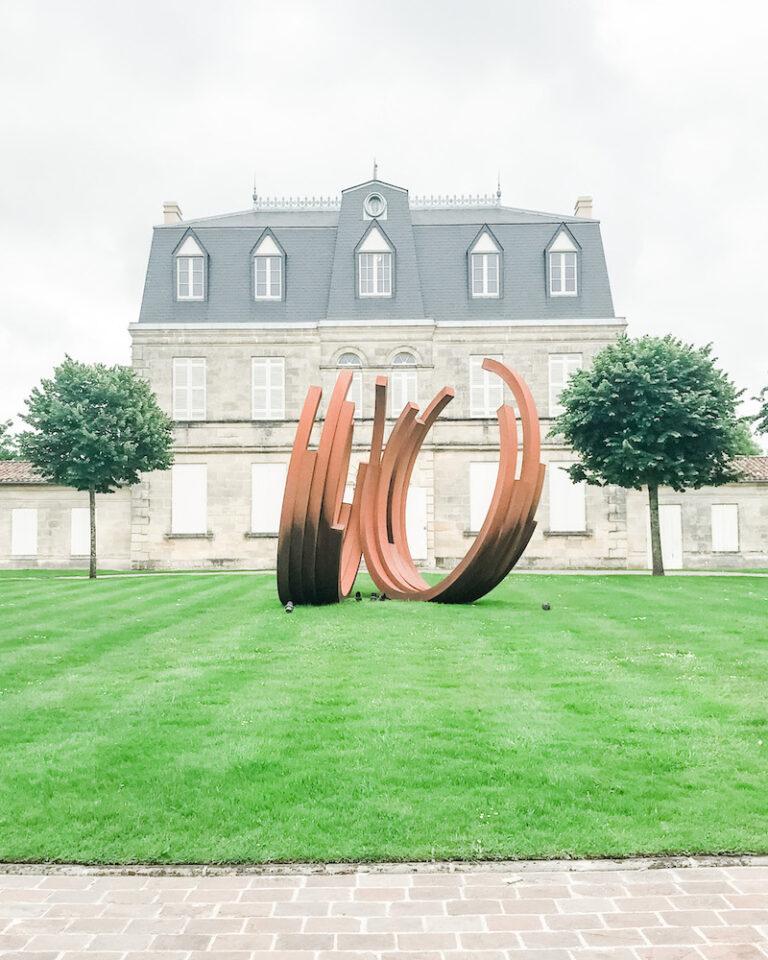Where to Sip, Eat, and Stay in Southern Québec’s Wine Regions
Looking to explore Quebec’s wine routes? Southern Québec blends small-town charm with a growing wine and food scene that’ll make you wonder why you didn’t visit sooner.
Think low-intervention wines, crisp sparklers, and some of the best ice cider out there. Plus, creative tasting menus, bike-friendly trails, and Nordic-style spas.
This region includes the Eastern Townships, Montérégie, and Centre-du-Québec, all within easy reach of Montréal, Quebec City, or the Northeastern U.S.
As a certified wine expert from New England, I’ve visited Québec many times. And I recently spent a week diving deep into the region’s wineries, cideries, and farm-to-table restaurants. Here’s where to sip, eat, and stay on your own Southern Québec adventure.
Thanks to Southern Quebec and Bonjour Quebec for hosting me. All thoughts and opinions are my own.
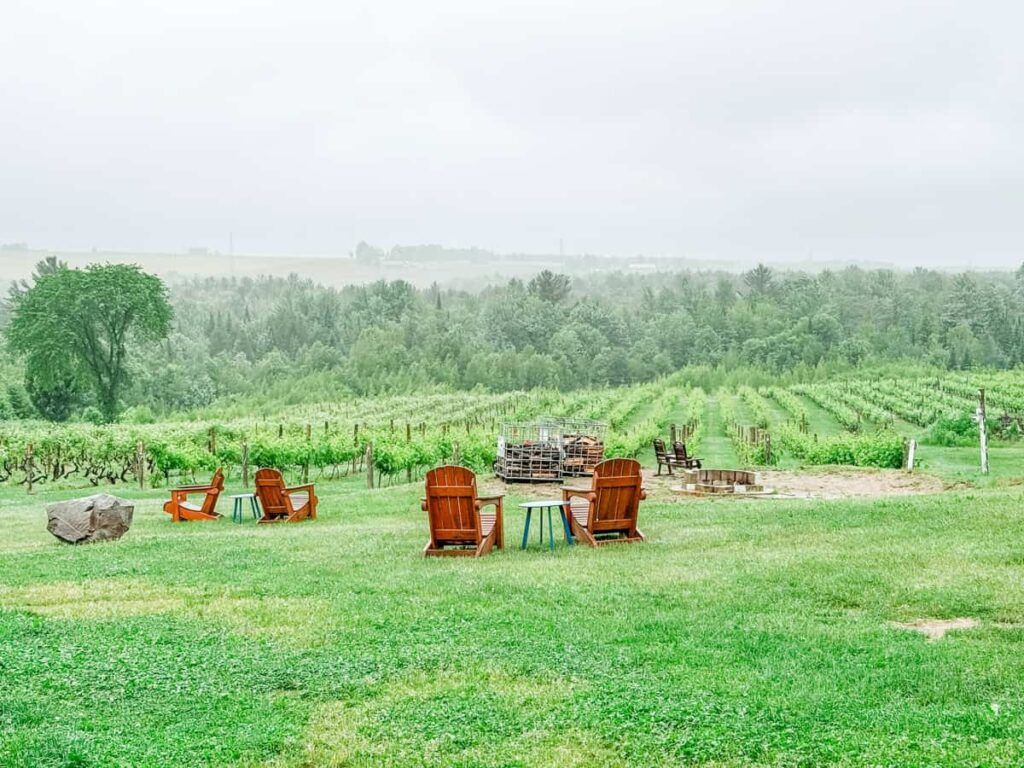
Eastern Townships
Québec’s most established wine region, the Eastern Townships, is the kind of place where you can hop on an e-bike, ride past rolling vineyards, and stop for tastings and local cheeses along the way.
It’s home to the Brome-Missisquoi Wine Route, which links 25 vineyards, many of them small, family-run producers. I only scratched the surface during this trip. But what I did experience made me want to come back for more.
Vignoble de l’Ardennais
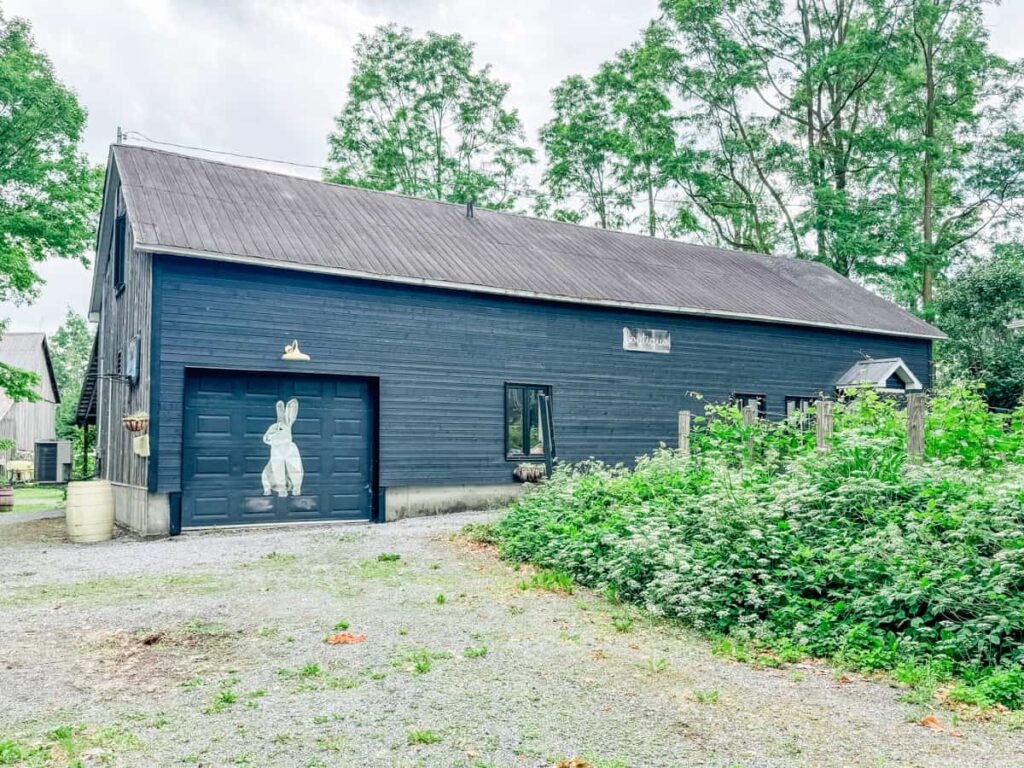
If you’re serious about high-quality, dry wines, Vignoble de l’Ardennais should be at the top of your list. It was my favorite winery of the trip.
The winery was founded about 30 years ago, but it’s been run since 2016 by Stéphanie Thibodeau and Pier Cousineau. After years in the restaurant world, they traded kitchens for vineyard rows and never looked back. Now their whole family helps run the winery.
They focus on cold-climate grapes like Seyval, Marquette, Petite Pearl, and Chancellor, as well as Pinot Noir and Riesling. Most of the wines are fermented to bone dry, with just 1.5 grams of residual sugar or less.
Pier personally led our tasting, and you could tell how much pride he takes in their wines. Between the firepit, tree swing, and family members helping out, it felt more like hanging out in someone’s backyard than visiting a tasting room, in the best way possible.
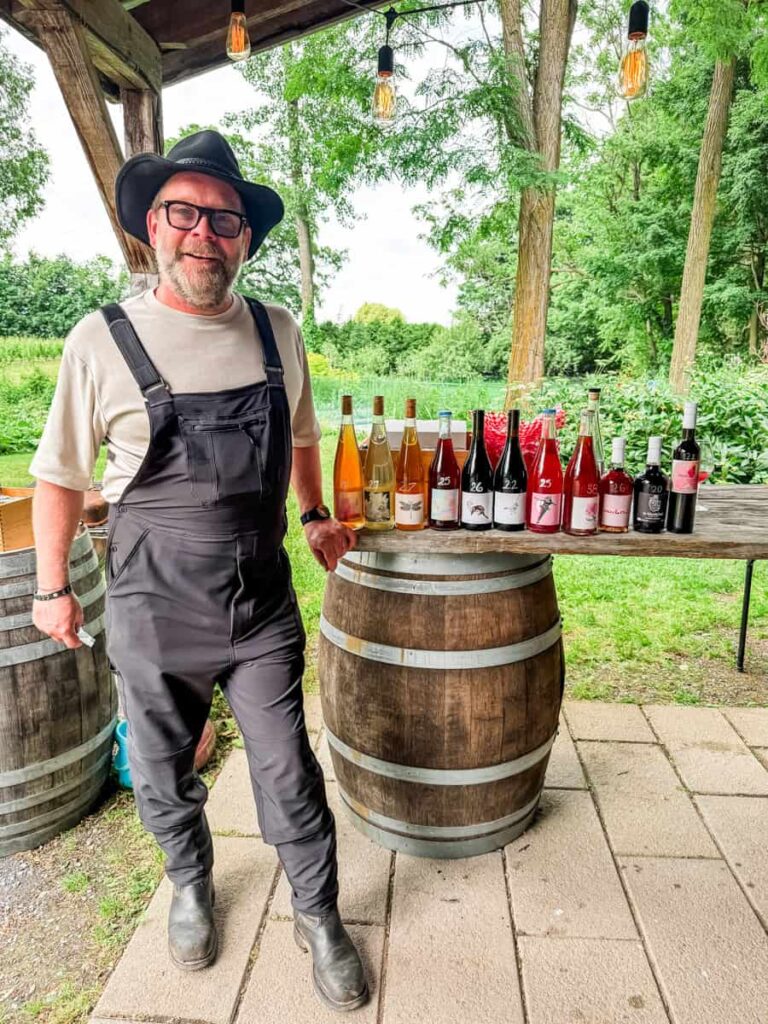
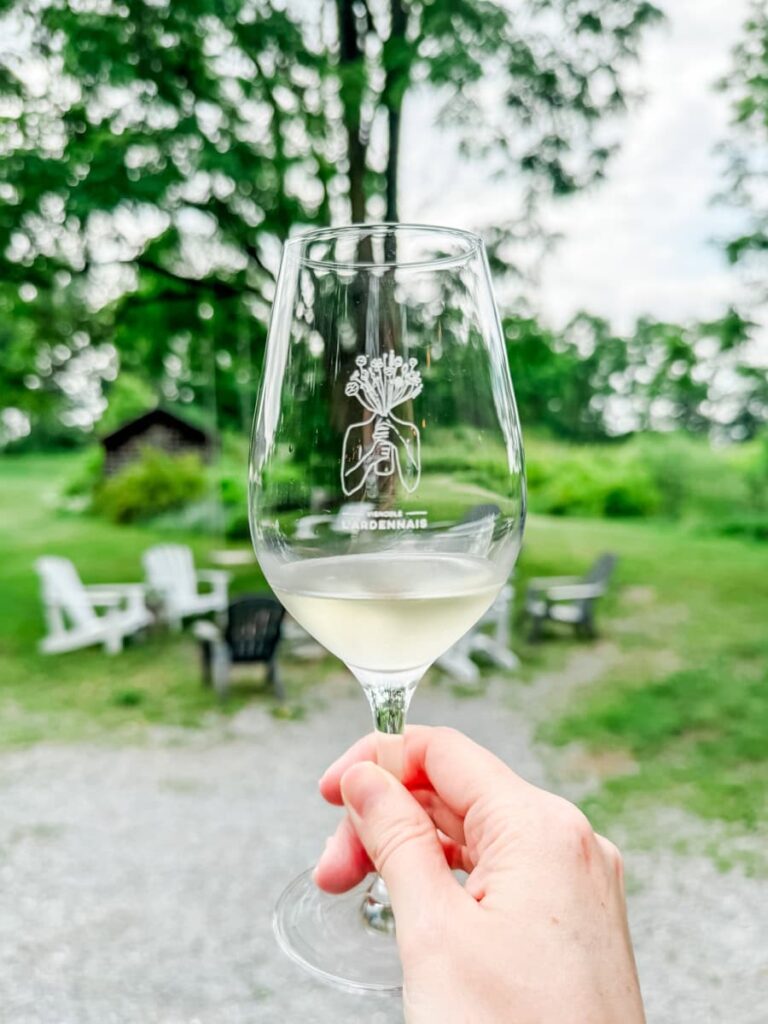
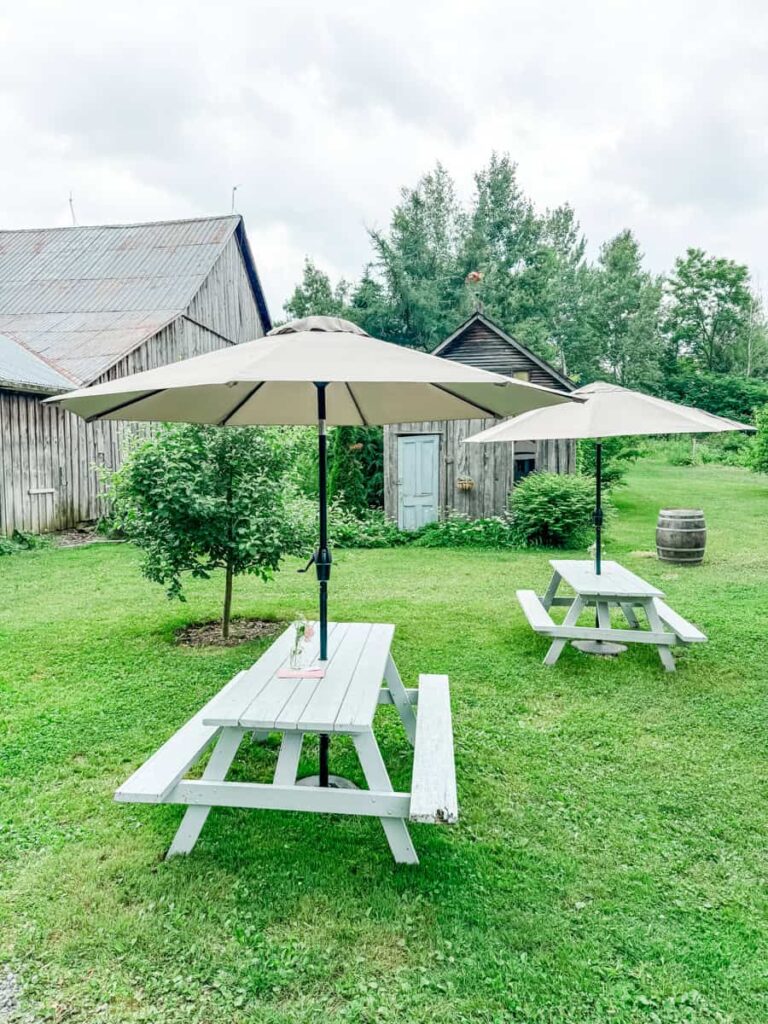
Vignoble de l’Ardennais, 158 Ch Ridge, Stanbridge East, QC
Domaine du Ridge
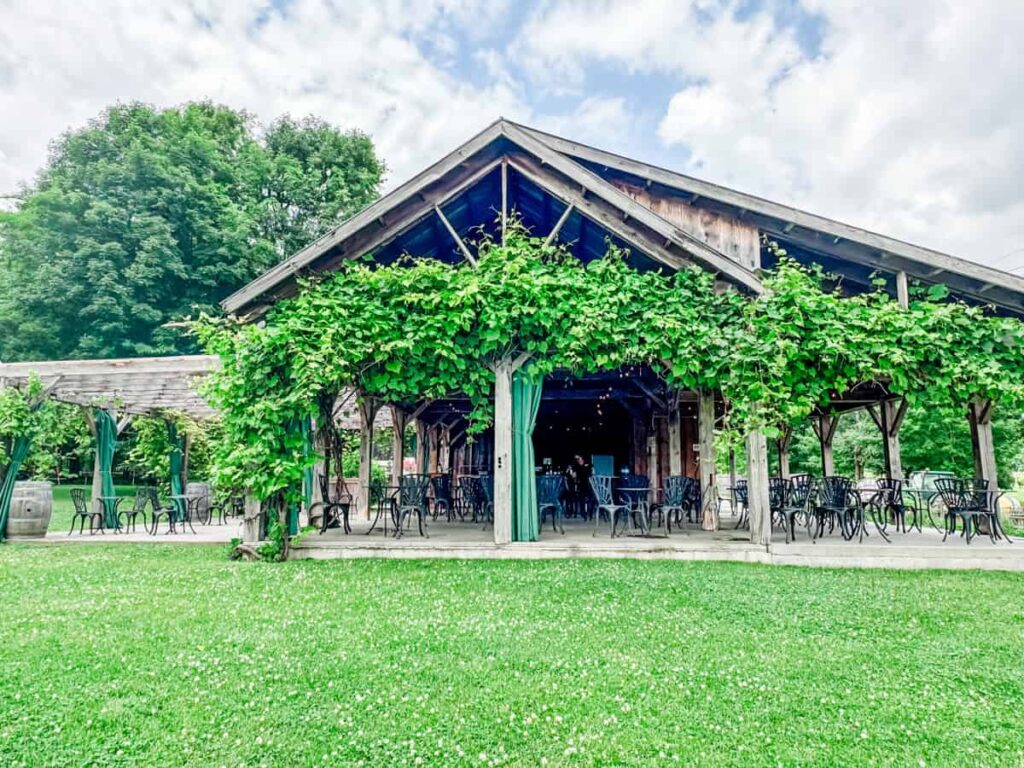
Domaine du Ridge is just down the road from Vignoble de l’Ardennais and makes a great stop if you’re traveling with a group or want a wide range of wine styles to try.
Founded in 1996 by Denis Paradis, Domaine du Ridge was one of the original wine route stops. What started with just 2,000 vines has grown into one of the largest vineyards in the province. And the team practices organic and biodynamic farming on hybrid varieties like Seyval, Vidal, and Maréchal Foch.
Before our tasting, I explored the grounds’ rustic barn-style buildings and pretty garden spaces. You can even see the trough where their grape-stomping event takes place each fall. The shop also has local food products and gifts worth browsing.
Our tasting was held on the patio overlooking the vineyard, with info in both English and French for our mixed group. They pour everything from reds to rosé to late harvest styles, and tastings come with a souvenir glass to take home.
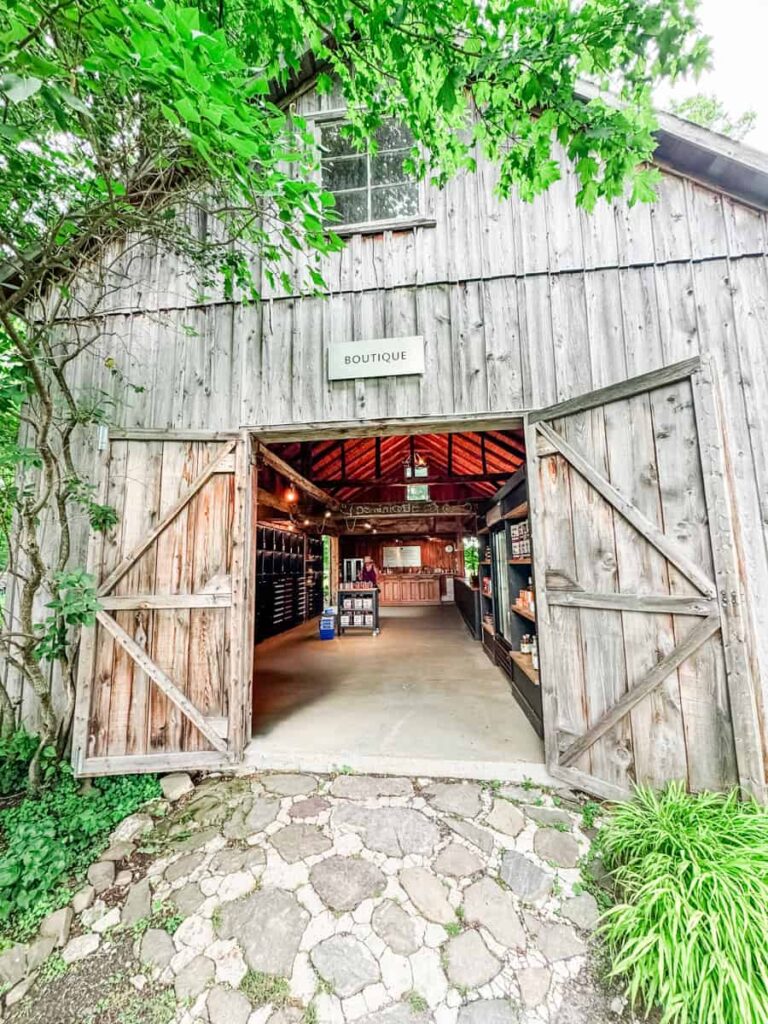
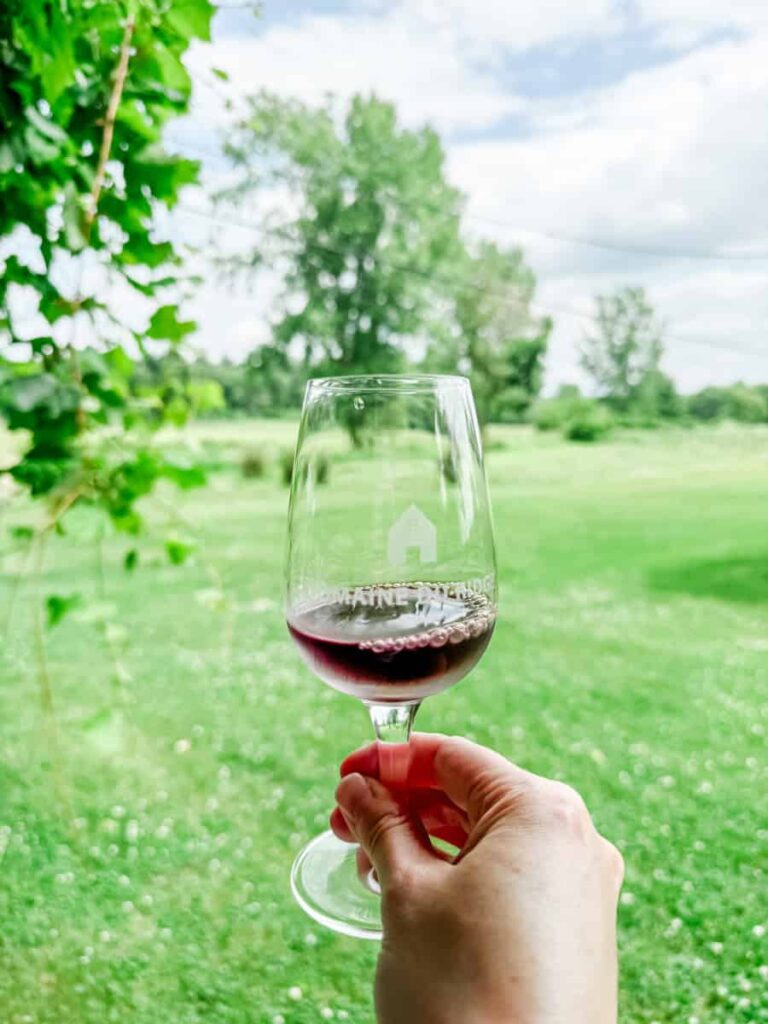
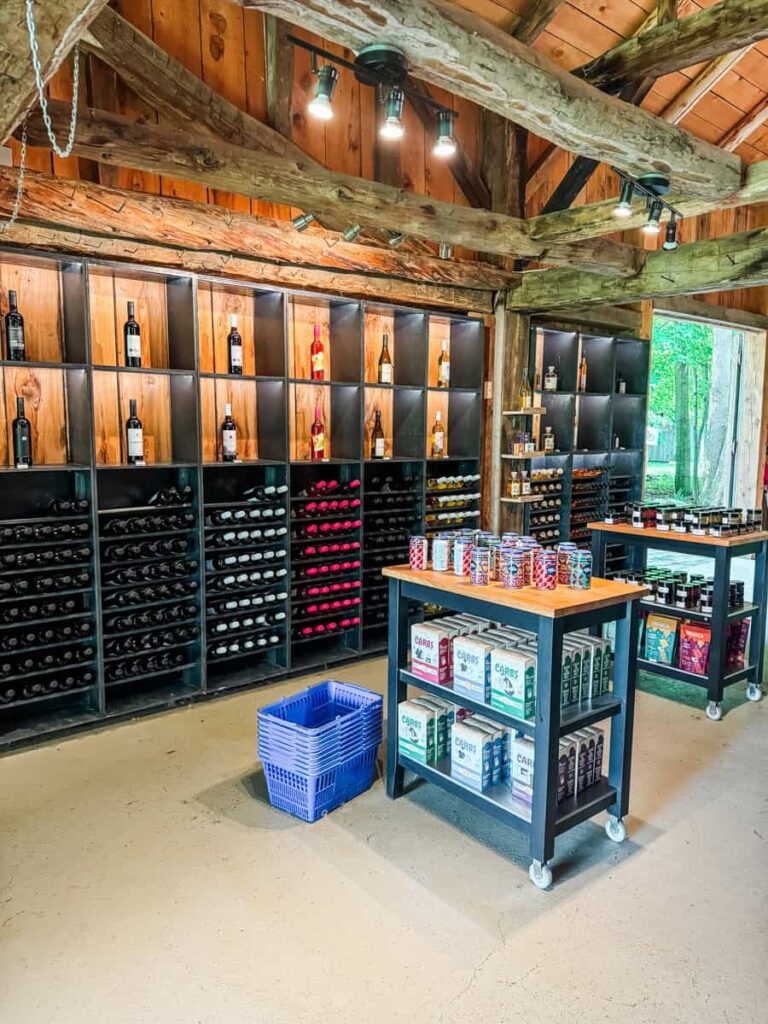
Domaine du Ridge, 205 Chemin Ridge, Saint-Armand, QC
Espace Old Mill
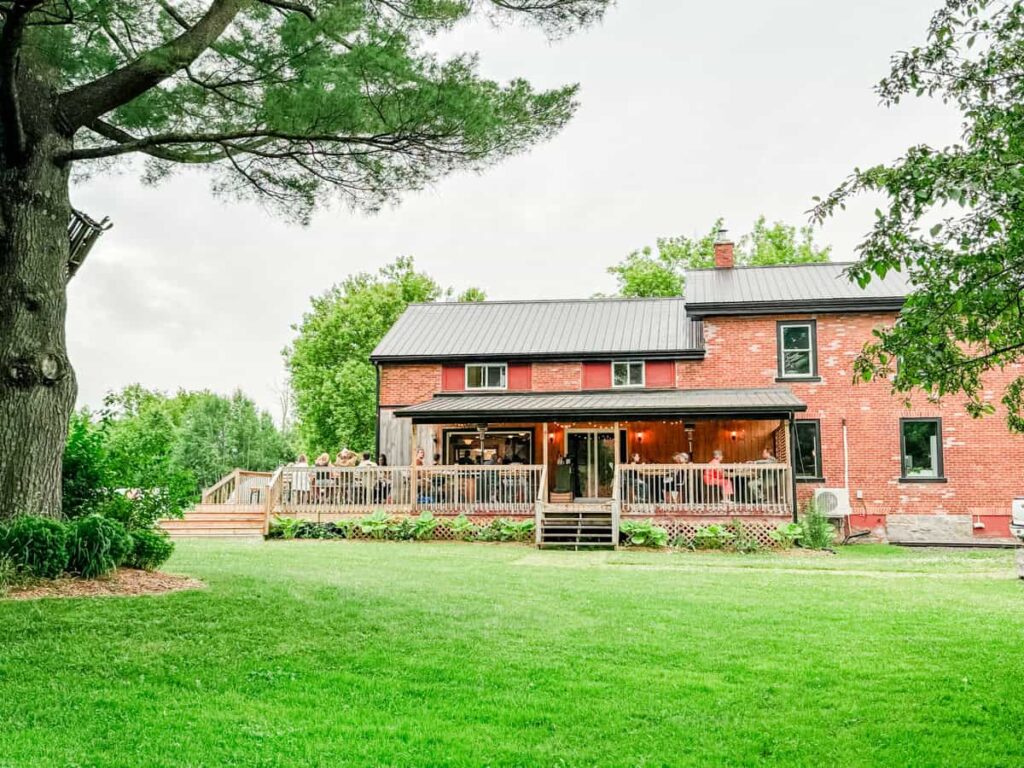
Set on a historic property next to a mill, Espace Old Mill takes farm-to-table to the next level. And they earned a Michelin Green Star for it.
The restaurant is the project of Jean-Martin Fortier, a well-known market gardener and advocate for local, sustainable food. The kitchen is led by Chef Éric Gendron, who brings fine-dining experience from top Montreal restaurants to this countryside setting.
Before dinner, Eric gave us a tour of the gardens and greenhouses, sharing how they plan the menu around what’s growing and available locally. That means no citrus or chocolate here. The five-course dinner that followed felt like being invited into someone’s home, with our group seated around a large dining table.
The menu was veggie-forward and full of surprises, like deer tongue (turns out it’s a type of lettuce) with miso, and celtuce with the best peas I’ve ever tasted. Most of the wines were Québec-made and brought out the best in each dish. The blended ice cider with the fennel and marigold dessert was one of my favorite finishes of the trip.
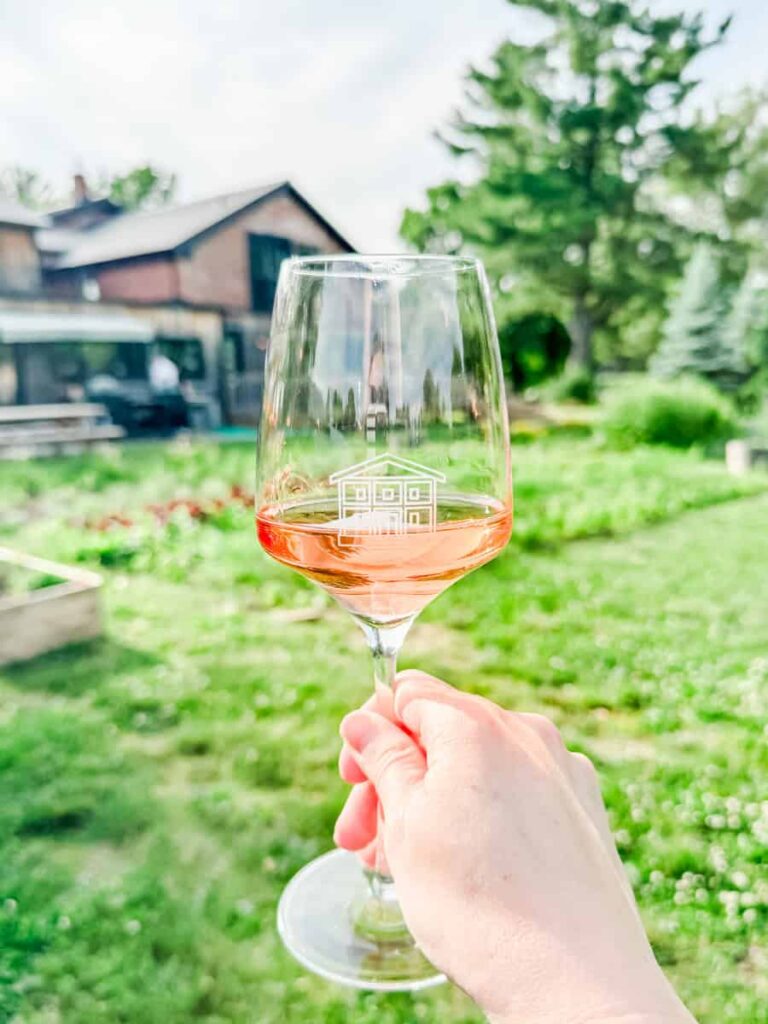
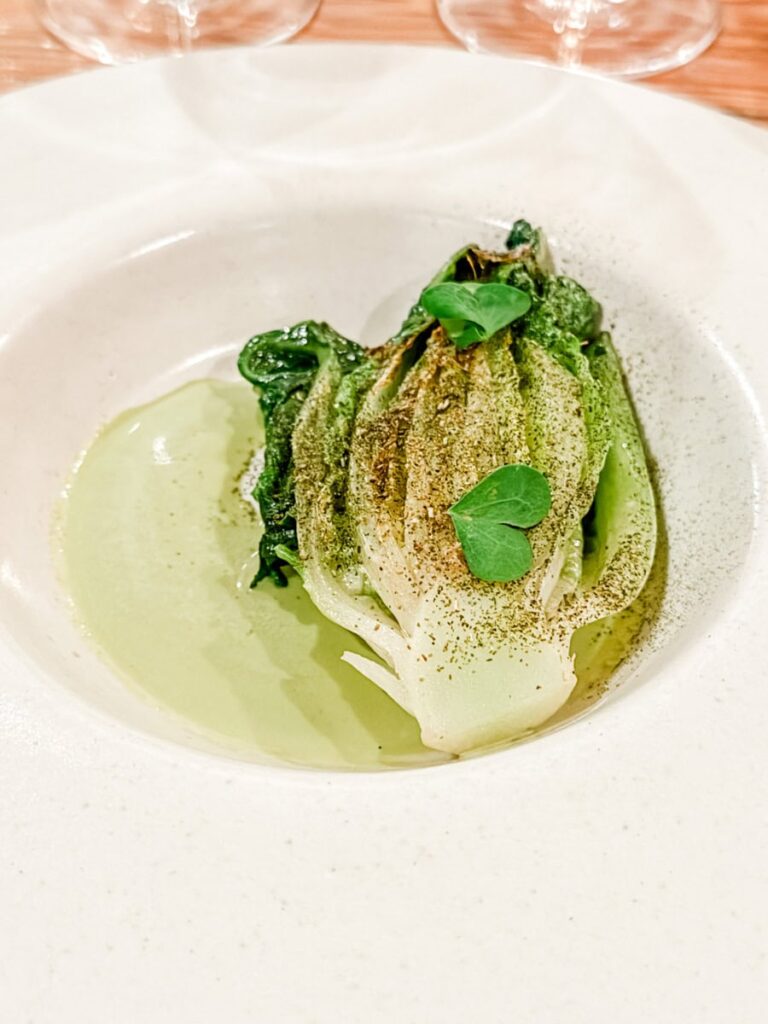
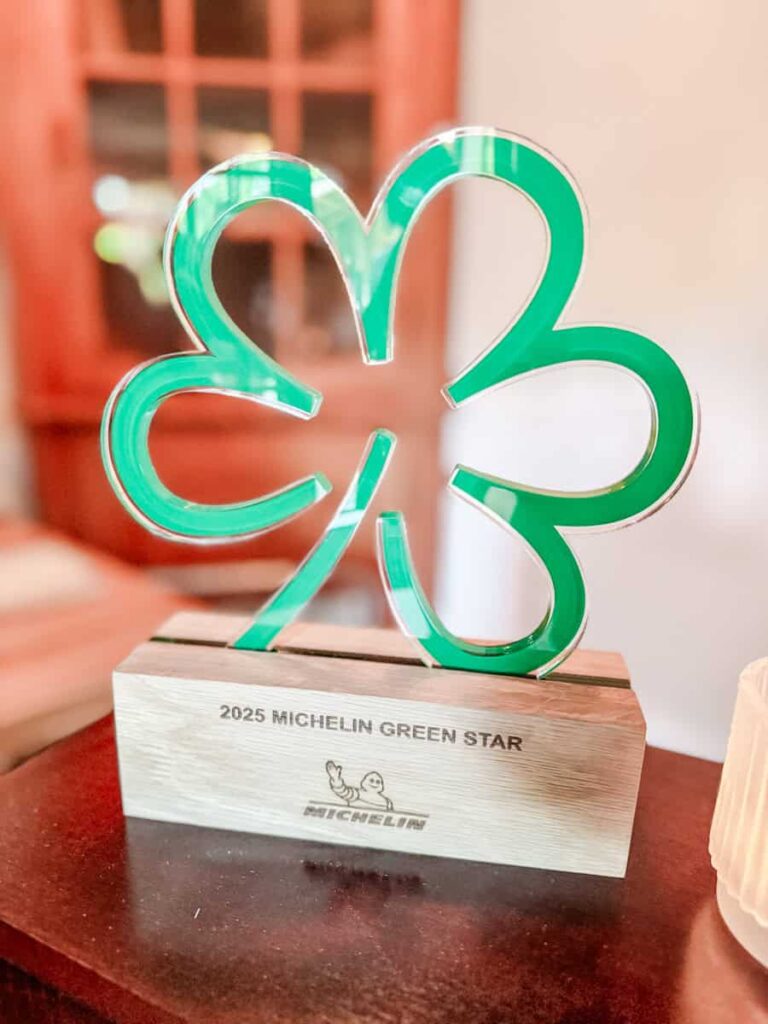
Espace Old Mill, 7 Chemin Caleb Tree, Stanbridge East, QC
Les Cocagnes
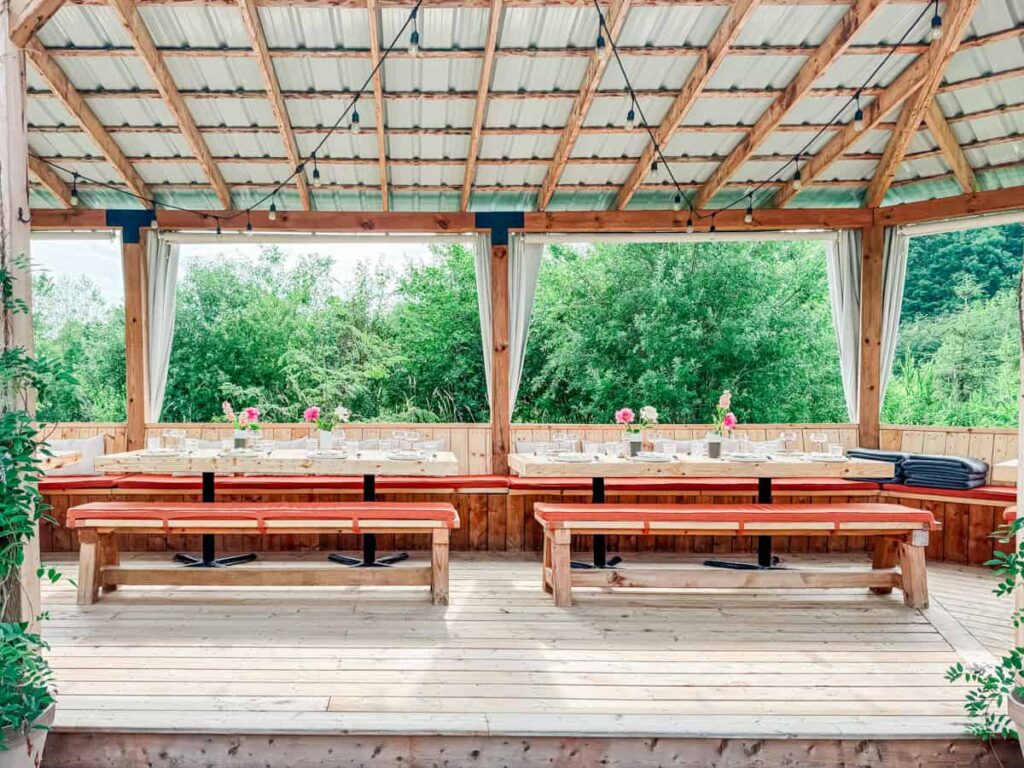
Les Cocagnes might just be one of the most unique dining experiences I’ve had. This nonprofit is reimagining agriculture by supporting small-scale ecological farms and funding that mission through unforgettable weekend dinners. Each one features a guest chef who creates a five-course menu using produce grown on-site.
The evening starts in a field dotted with octagonal seating pods. Canned cocktails were paired with jamón sliced right off the bone. This was followed by a short garden tour, where we learned about the farm and the project’s goals.
Dinner is served under a stunning open-air pergola by a pond, with long communal tables, sun shades, and heaters for cooler nights.
Our guest chefs, Sylvain Dervieux and Émilie Tremblay of Faux Bergers, served creative, flavorful dishes paired with local wine and cider. Like the cabbage with house kimchi and crispy wild rice, matched with the bright apricot notes of a Chardonnay. Or my favorite: crispy hemp with confit pork and koji pork rillons paired with a peppery Pinot Zweigelt. It was an evening I’ll be thinking about for a long time.
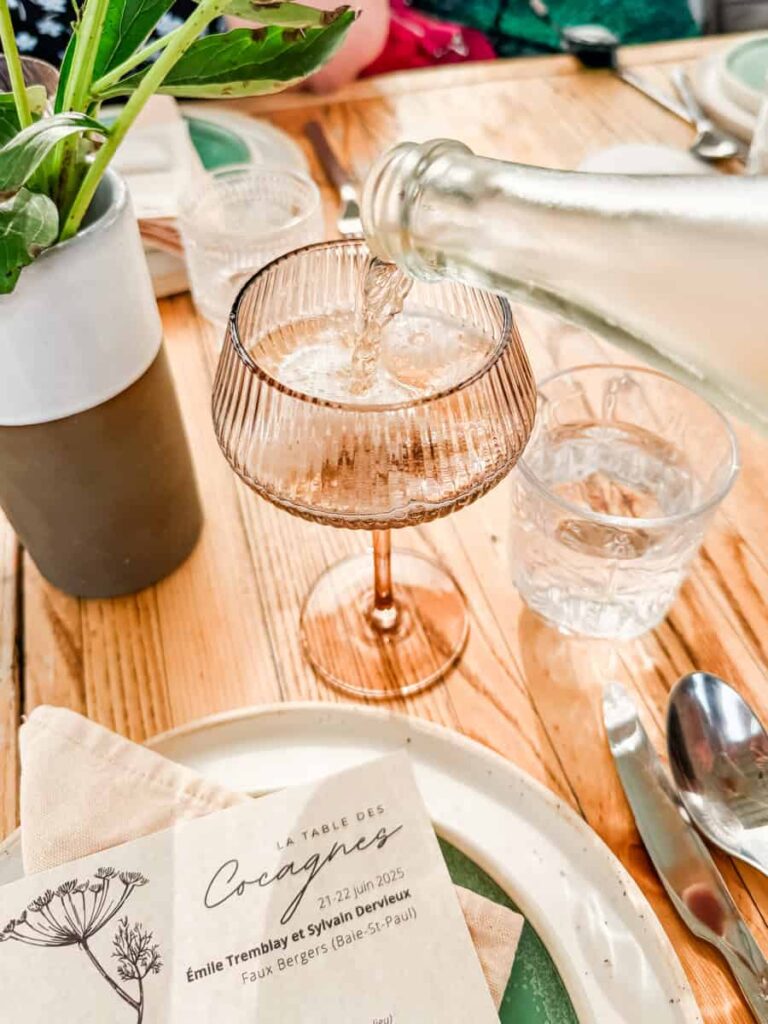
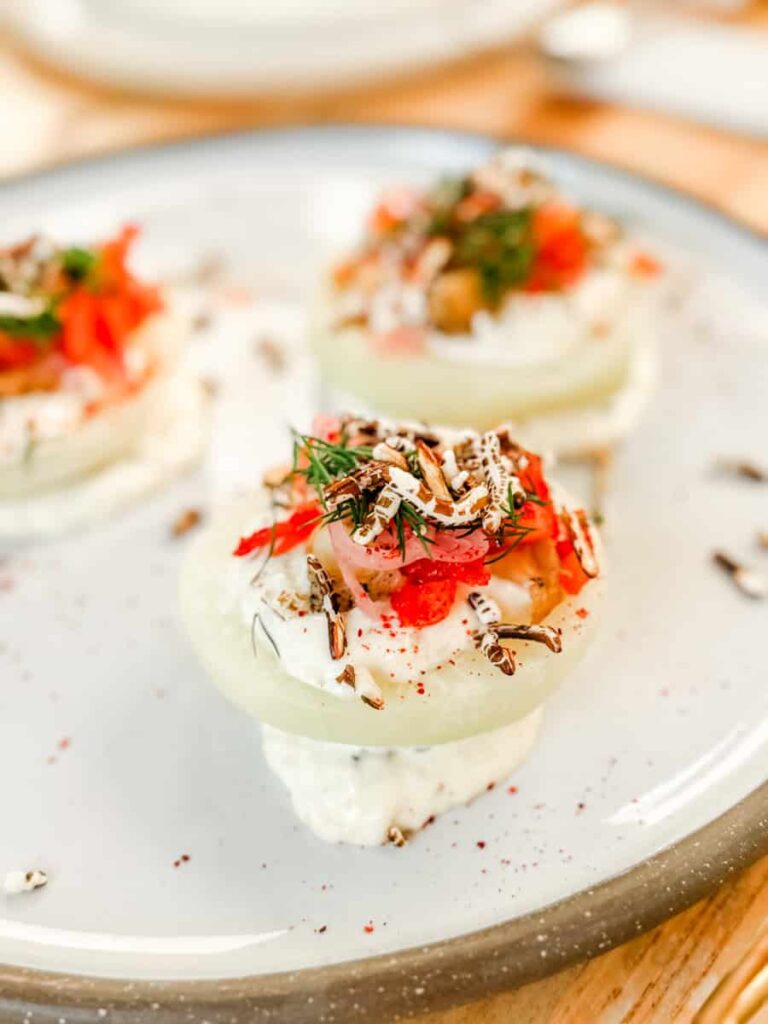
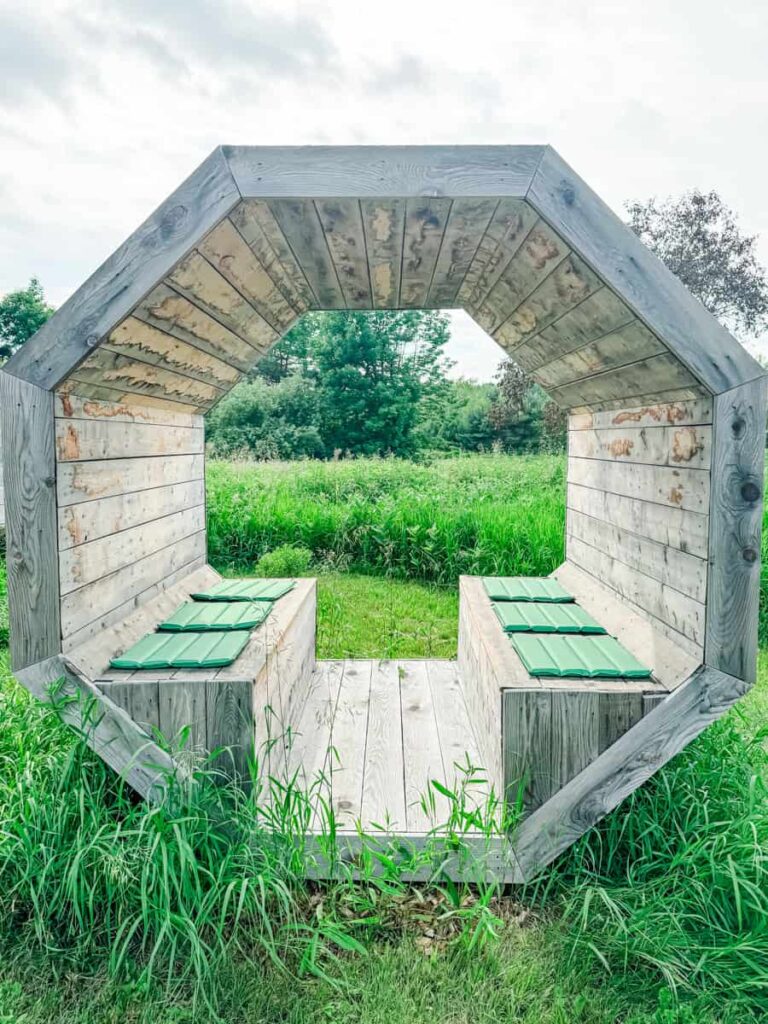
Les Cocagnes, 33 Chemin de Dunham, Frelighsburg, QC
Other Things to Do in the Eastern Townships
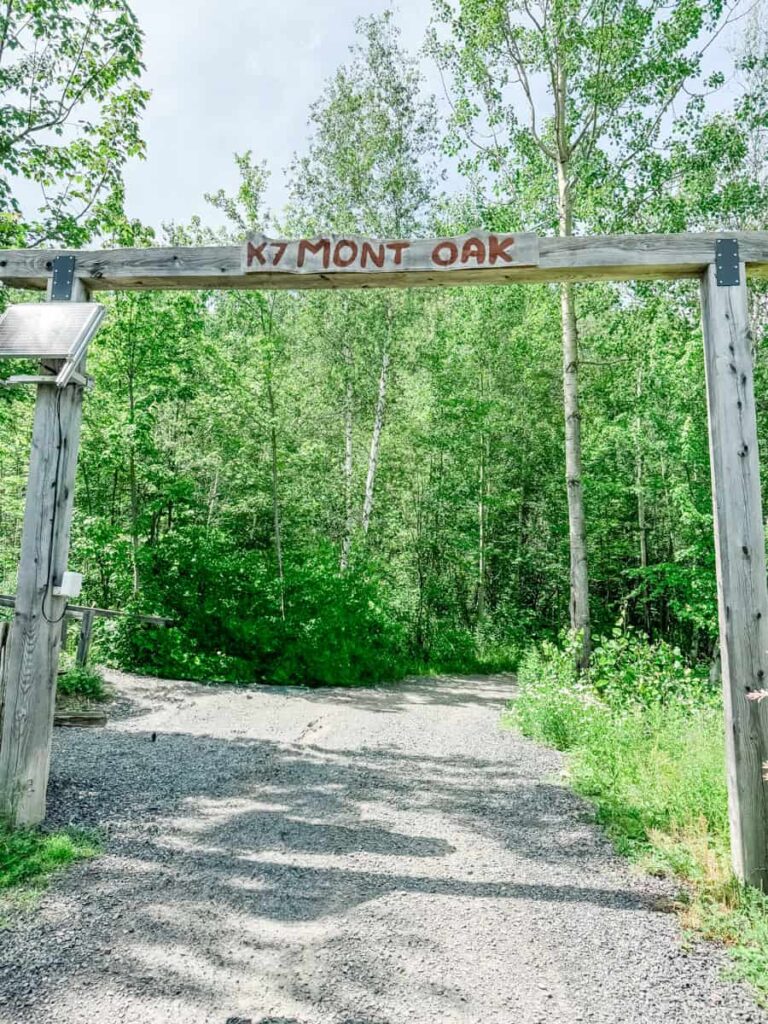
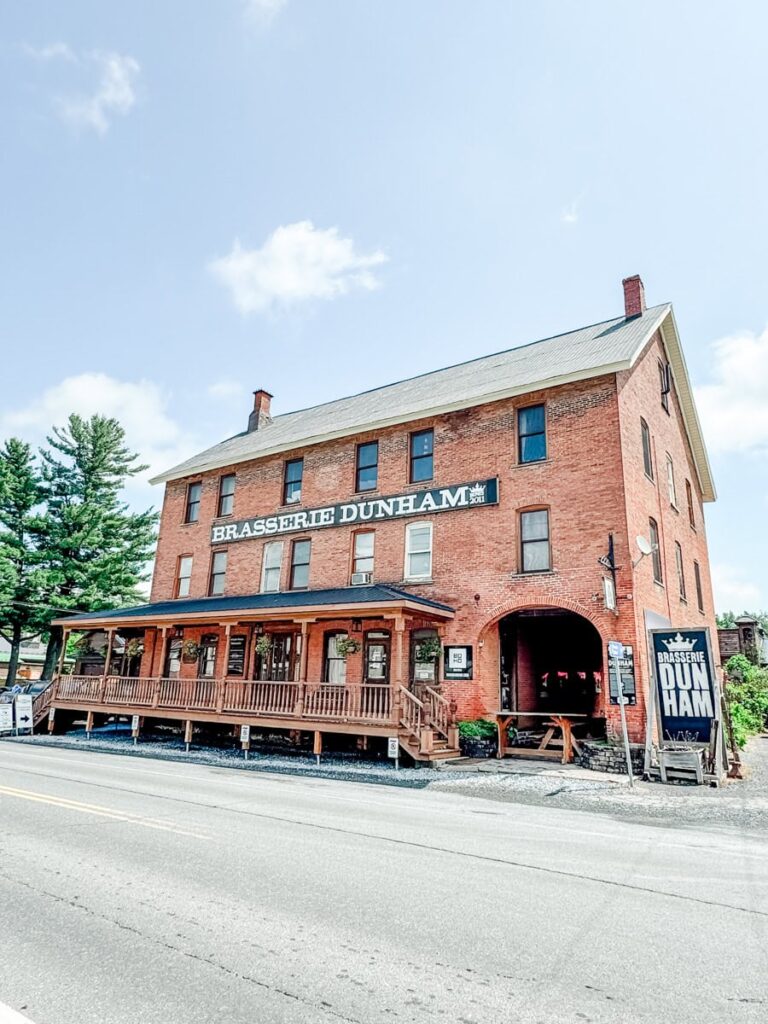
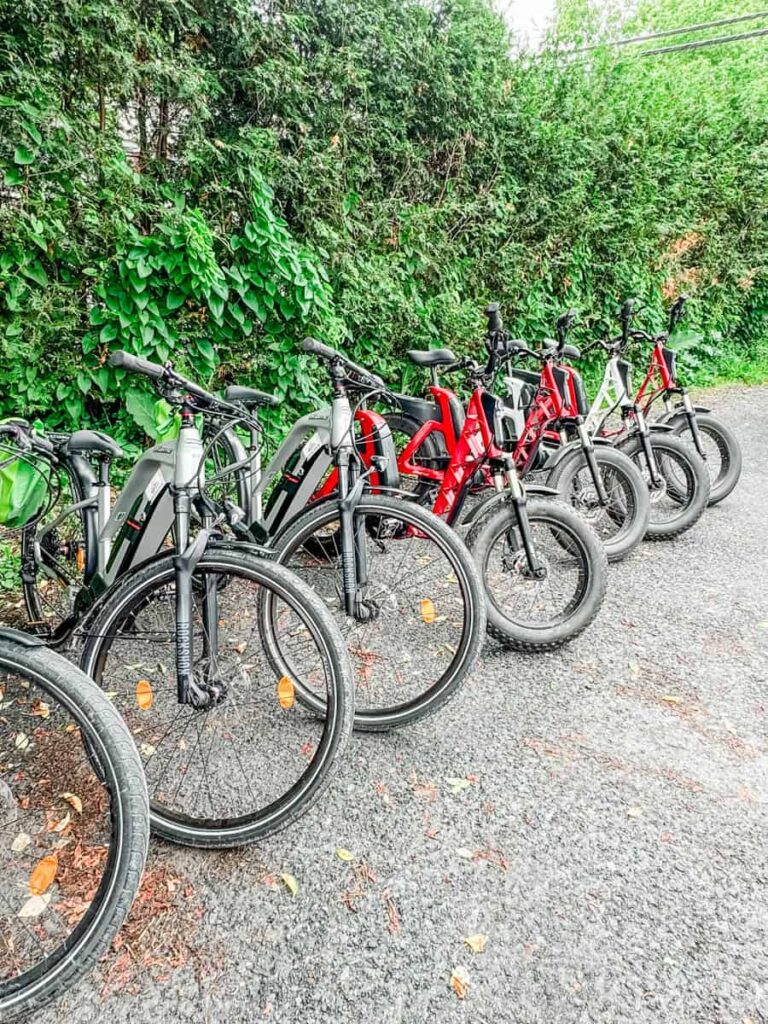
The wine is reason enough to visit, but there’s plenty more to explore between tastings. The Eastern Townships is a true four-season destination, with hiking and bike trails, thermal spas, local breweries, and ski slopes just a short drive from the vineyards.
- Ride the Wine Route by E-Bike: Rent electric bikes for a scenic ride along the Brome-Missisquoi Wine Route. The route follows quiet country roads, with plenty of vineyard stops (and views) along the way.
- Hike the Trails at Parc des Sommets: This extensive trail network in Bromont offers peaceful wooded paths, mountain views, and easy loops perfect for a mid-trip stretch. I joined a guided hike, but you can explore on your own too.
- Visit a Local Brewery (or Several): With more than 30 breweries in the region, the Eastern Townships are also a great destination for beer lovers. I had lunch at Brasserie Dunham, which pairs creative brews with pizza, burgers, and poutine in a cute downtown setting.
- Hit the Slopes: The region has four ski mountains, including Bromont, a top night skiing destination.
- Relax at a Spa: The Townships is home to more than a dozen spas, many designed in a Nordic style with outdoor thermal pools, saunas, and peaceful nature settings.
Where to Stay in the Eastern Townships
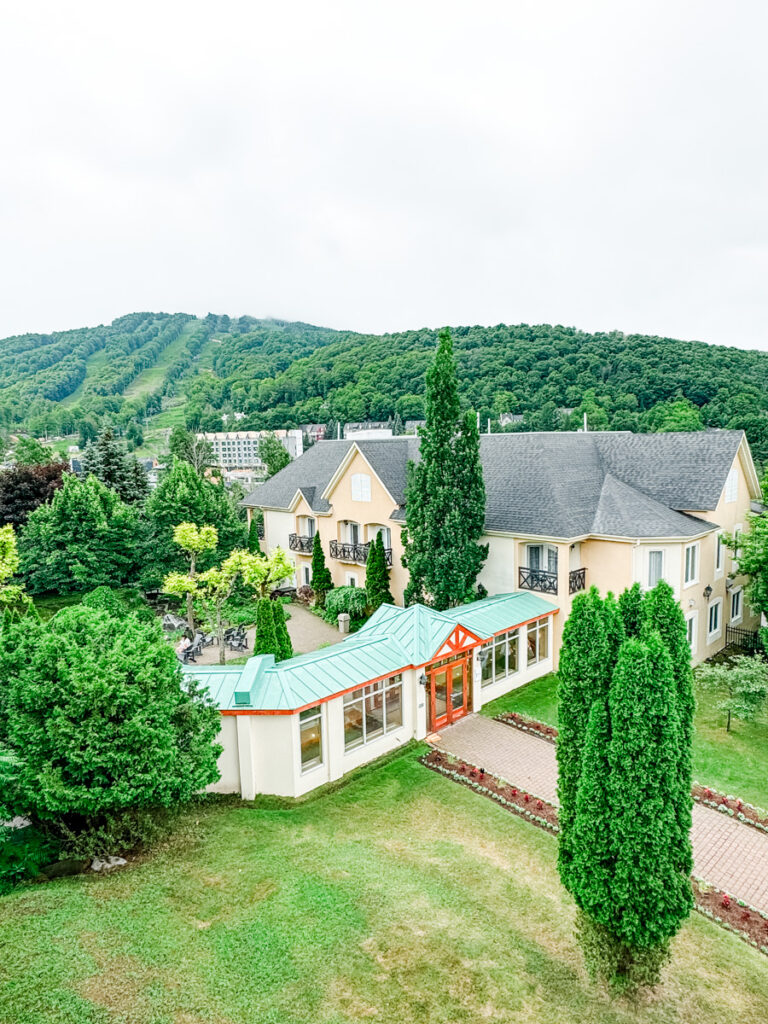
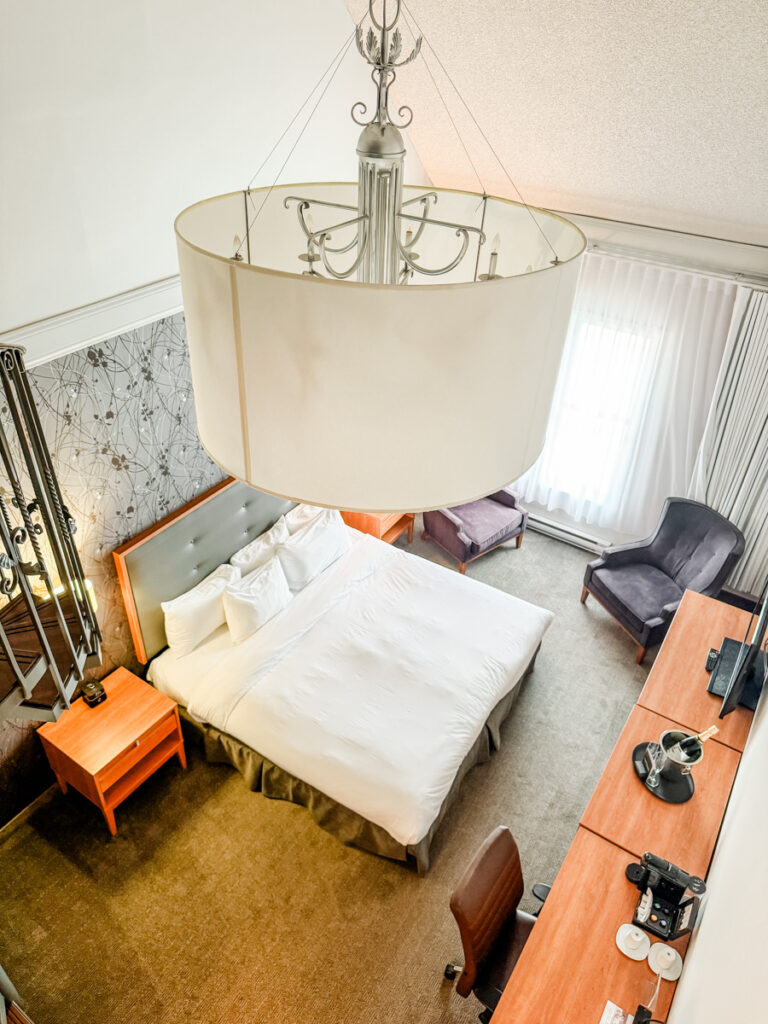
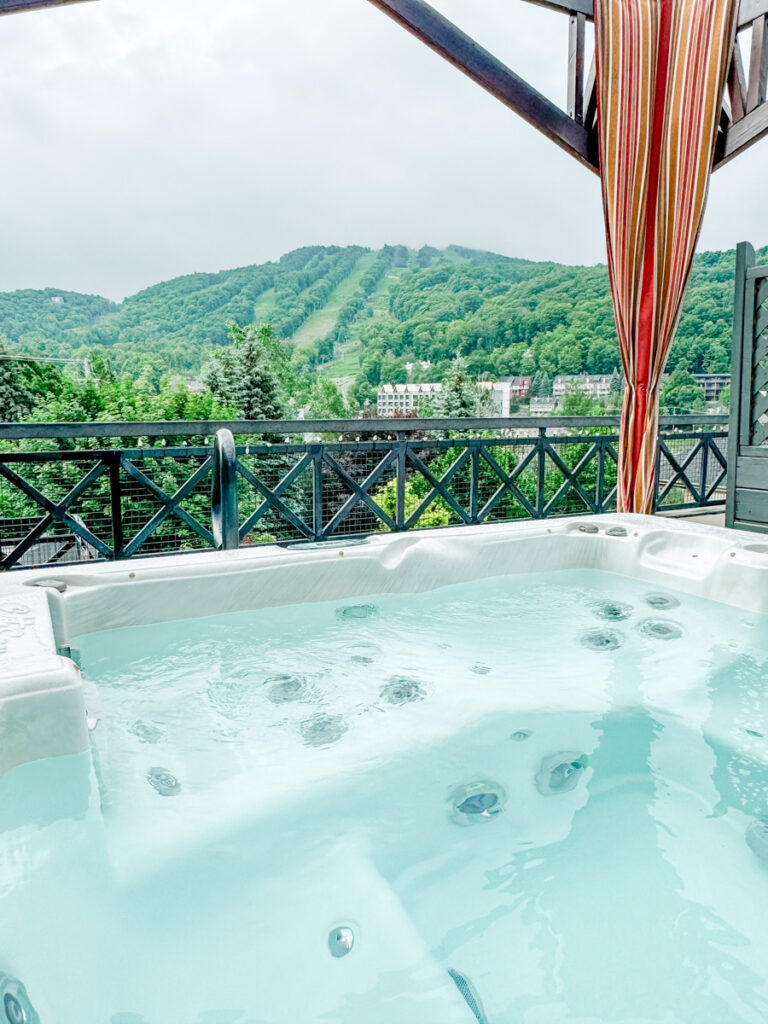
Château-Bromont makes a perfect home base in the Eastern Townships, especially if you want some relaxation between wine tastings.
The hotel sits at the base of Mount Bromont, one of the largest night skiing resorts in North America, and is a short drive from the Brome-Missisquoi Wine Route. It has panoramic views of the valley, indoor and outdoor pools, a spa, and rooftop hot tubs that would be perfect for an après-ski soak in winter. It’s also just minutes from hiking trails and biking routes.
I stayed in one of their two-story rooms with a king bed on the main floor and a queen upstairs. It would be a great setup for a family trip or a weekend getaway. The breakfast buffet was delicious, especially the little egg cups topped with hollandaise. I could’ve easily spent a full week here, and I’m already thinking about returning.
🏨 Book the Château-Bromont
Recommendations may be affiliate links on which I earn a small commission at no additional cost to you. This helps me share new wine destinations with you and I only recommend products and services that I love and think you’ll love too!
Montérégie
Just a short drive from Montréal, Montérégie is known as the pantry of Québec. And for good reason. The fertile soil here supports everything from fruit farms to vineyards, making it a hub for local producers.
While cider takes center stage, the wine scene is growing fast, with newer vineyards leaning into French styles, dry rosés, and crisp whites made from vinifera grapes. Add in a relaxing spa experience and a maple-filled sugar shack meal, and Montérégie delivers plenty to sip and savor.
Coteau Rougemont
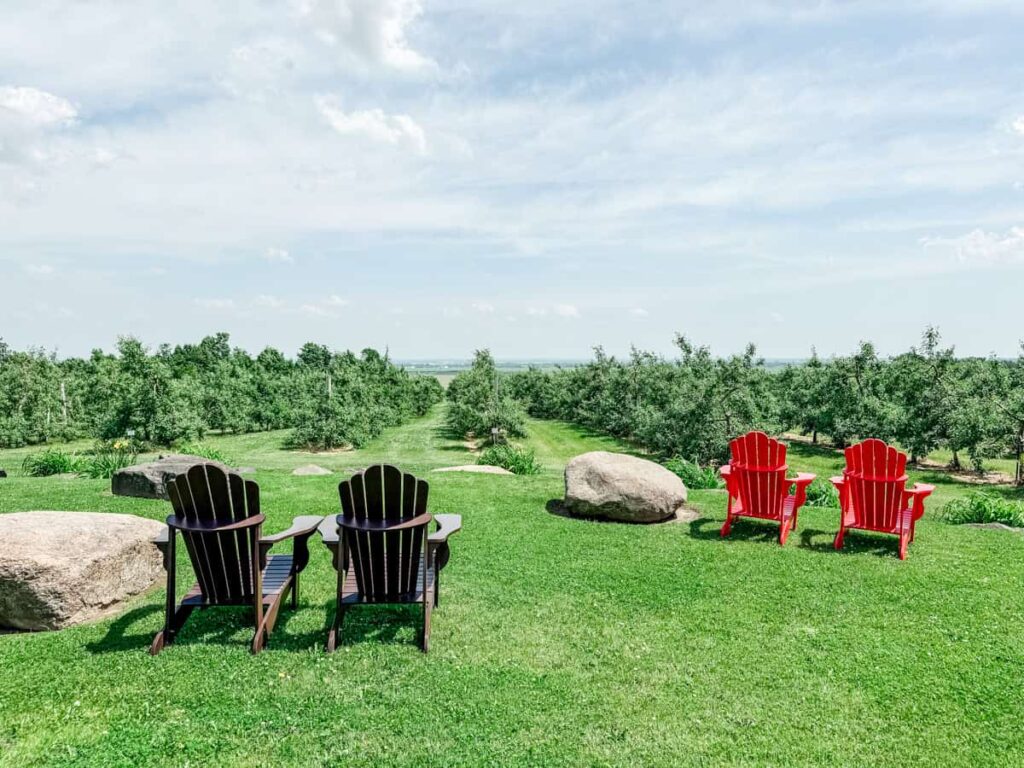
Coteau Rougemont is just 20 minutes from Montreal but feels a world away. It’s a great stop if you’re looking to try both wine and cider in a beautiful setting.
The Robert family planted their first vines in 2007, bringing to life a longtime dream and creating one of the region’s top spots for sipping with a view. Today, they produce a wide range of wines, ciders, and maple products, all made on-site from what’s grown on the family’s land.
As soon as I stepped onto the terrace, the panoramic views hit me, with rolling orchards in every direction. I loved how they set up the space, with Adirondack chairs scattered across the lawn and plenty of tables under the covered patio. It was a hot day, so we grabbed a shady spot and tasted through a flight of chilled wines.
Inside, there’s a lounge area with a circular fireplace surrounded by couches. I could easily picture coming back on a chilly day to warm up there with a glass of red.
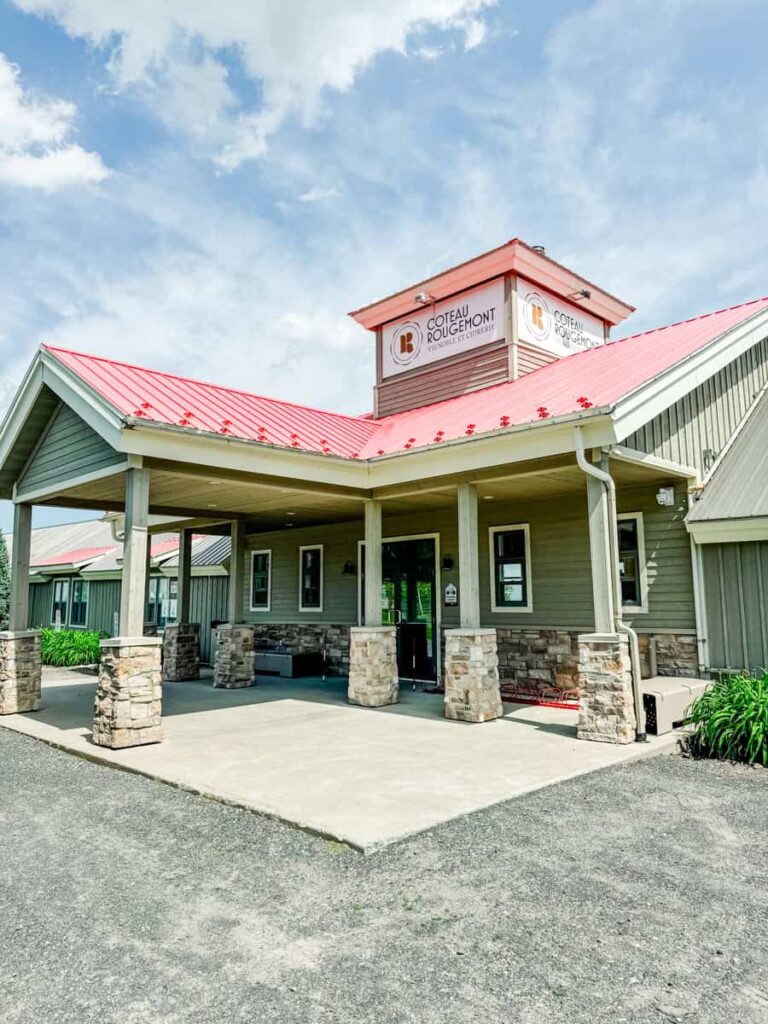
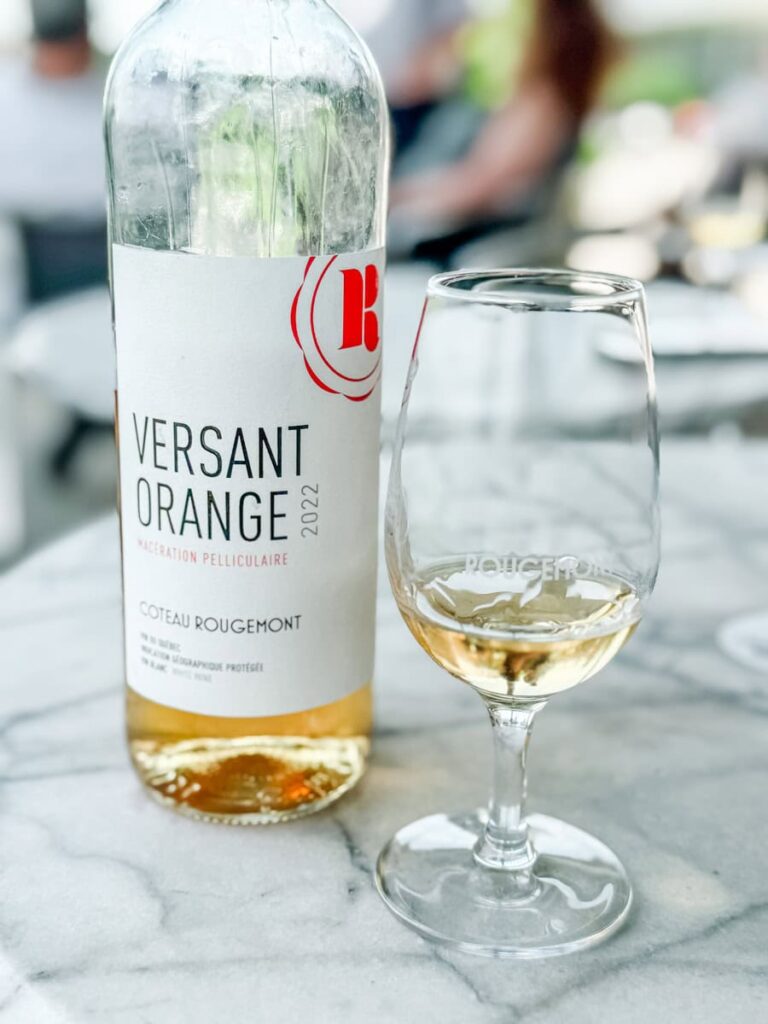
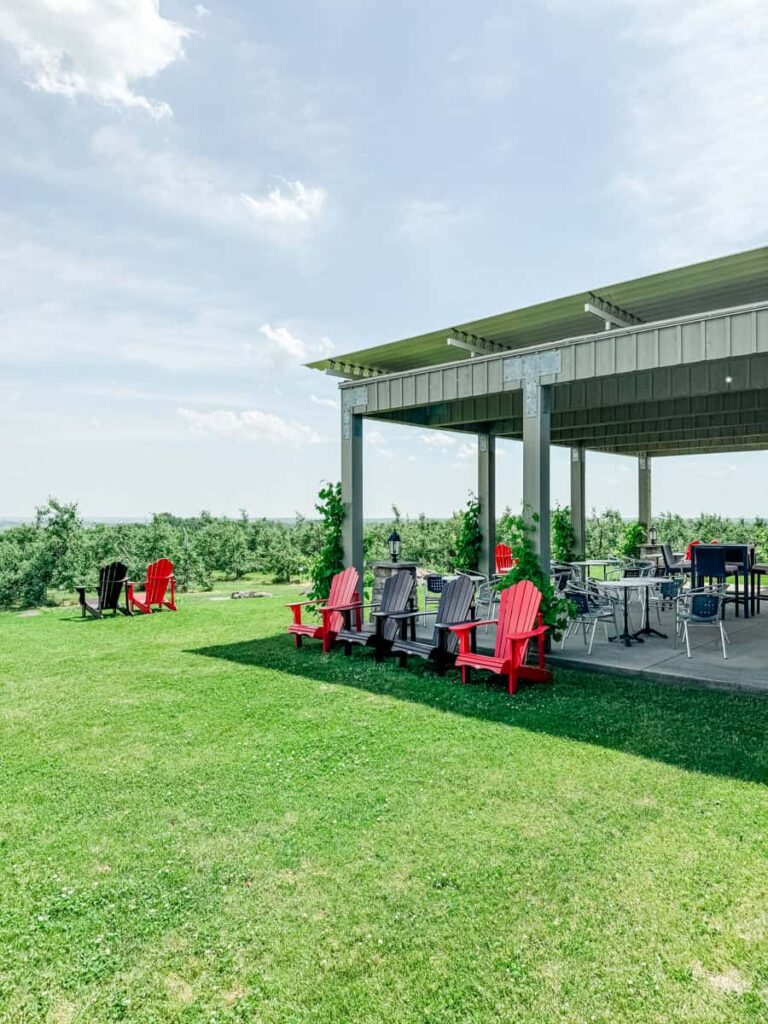
Coteau Rougemont, 1105 Petite Caroline, Rougemont, QC
Cidrerie Michel Jodoin
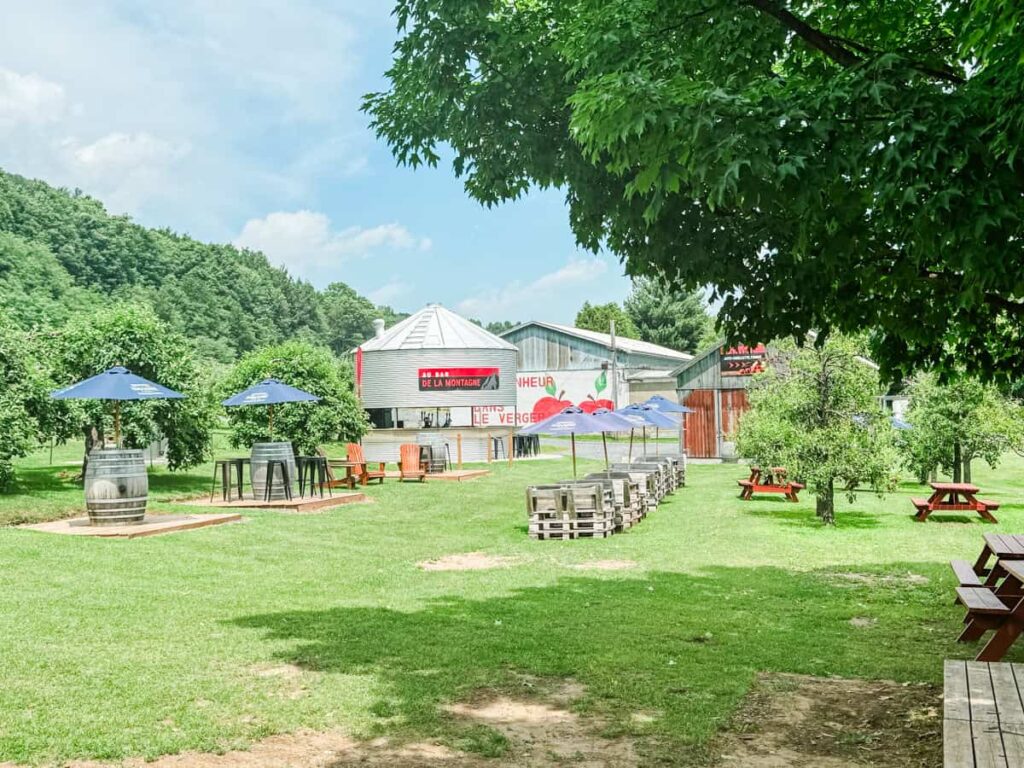
Cidrerie Michel Jodoin is a must for cider and wine lovers alike. Set at the base of Mont Rougemont, this fifth-generation orchard produces some of the best ciders I’ve ever tasted using winemaking techniques.
Founder Michel Jodoin brought back inspiration from France in the 1980s, introducing traditional-method sparkling ciders to Québec. Since 1988, the cidery has grown its production without sacrificing quality. And they’ve expanded into apple-based spirits.
I loved the tasting room’s fun vibe, with its rows of bright bottles, colorful signage, and fireplace seating. Through the doors at the back, you can check out the cellar where barrels are stacked for production. There’s also plenty of outdoor space to enjoy, including picnic tables, barrel high tops, and a bar built into an old silo right next to the orchards.
We brought along picnic supplies from a stop at Ferme Guyon and paired them with the cider tasting. The traditional-method sparkling rosé was a standout, but I’d go back in a second for the ice cider too.
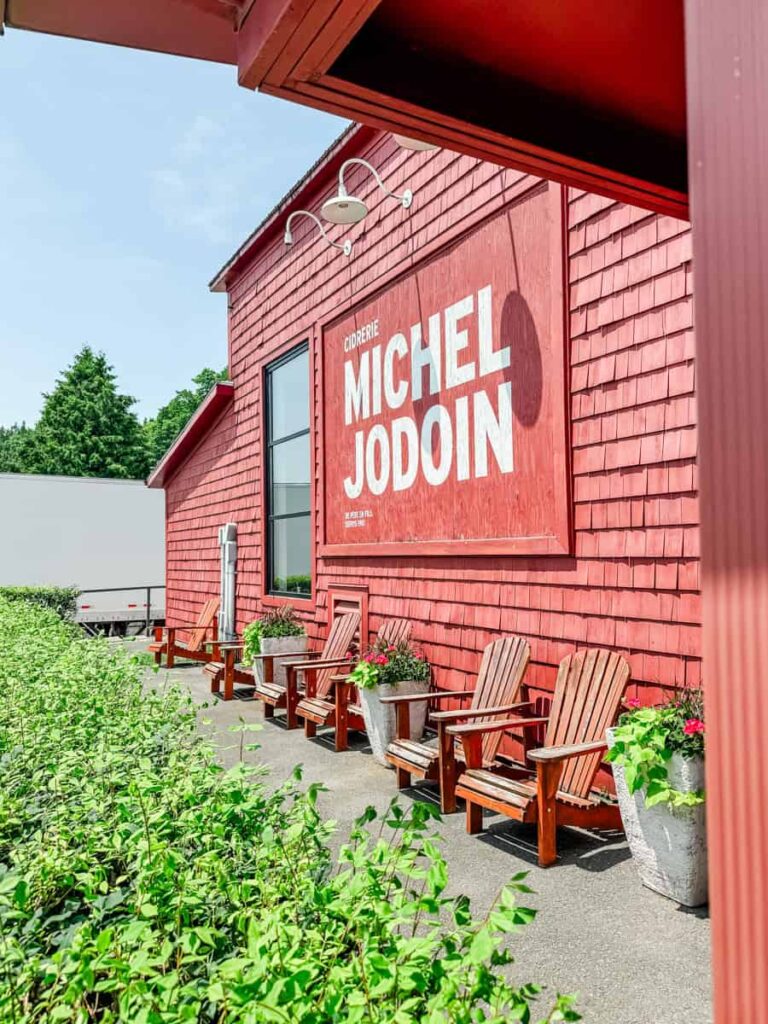
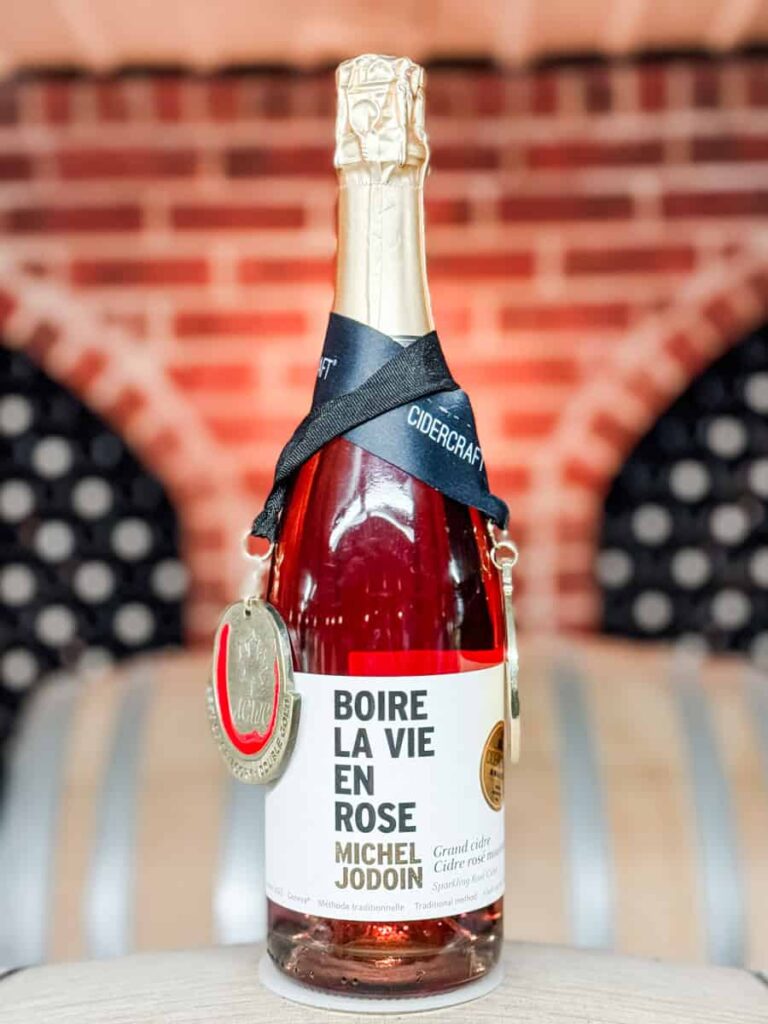
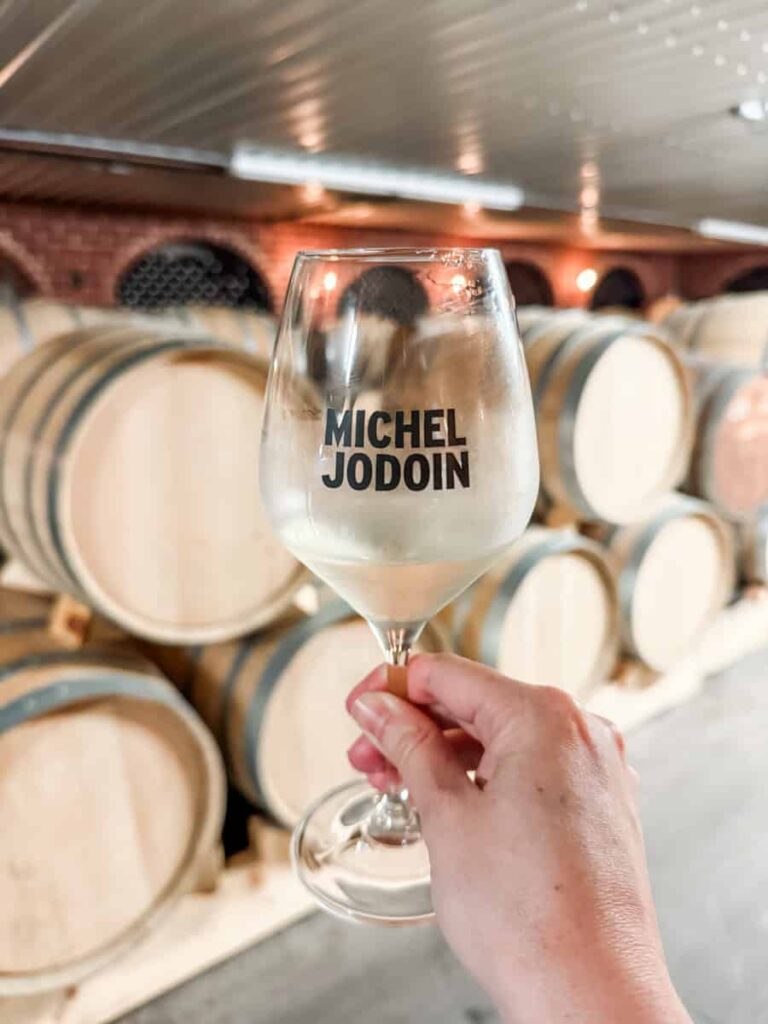
Cidrerie Michel Jodoin, 1130 La Petite-Caroline, Rougemont, QC
Nord
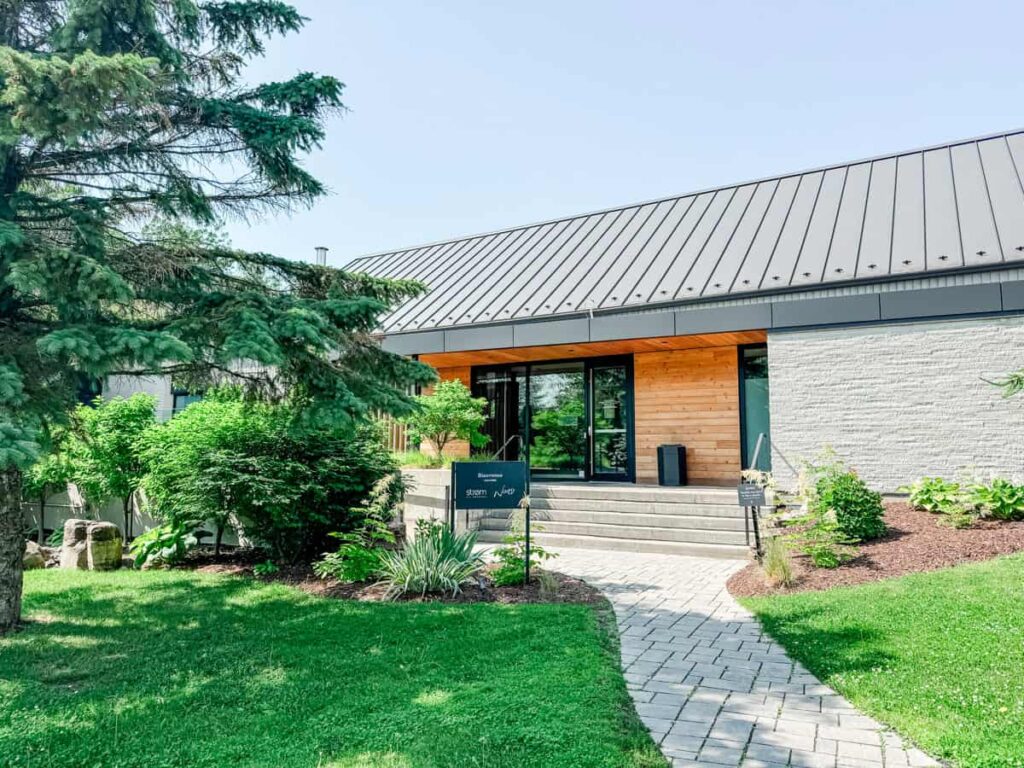
If you’re looking to pair your spa day with a gourmet dining experience, Nord has you covered. This serene, light-filled restaurant overlooks the thermal pools at Strøm Nordic Spa in Mont-Saint-Hilaire and serves up seasonal dishes with a Nordic twist. You can even dine in your robe if you’re taking a break between spa treatments.
The menu features local ingredients used in creative ways. I started with a beautiful platter of local cheeses and charcuterie, paired with a refreshing sparkling tea made from spring water.
For my main, I chose the smoked duck with black garlic eggplant caviar, sour cherries, and a mushroom-asparagus salad. This was a great match for a Pinot Noir made by local producer Camy. And the dessert, a maple Paris-Brest with blackcurrant and northern hazelnuts, tasted as beautiful as it looked.
Dining at Nord after soaking at the spa was the ultimate way to end a relaxing afternoon.
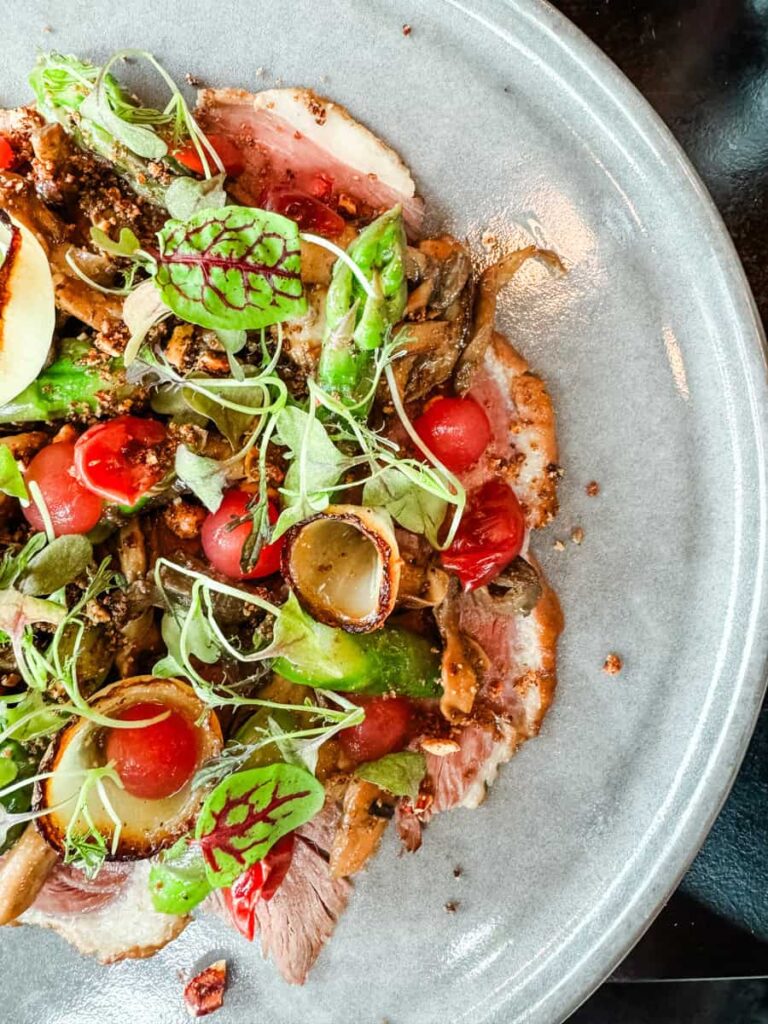
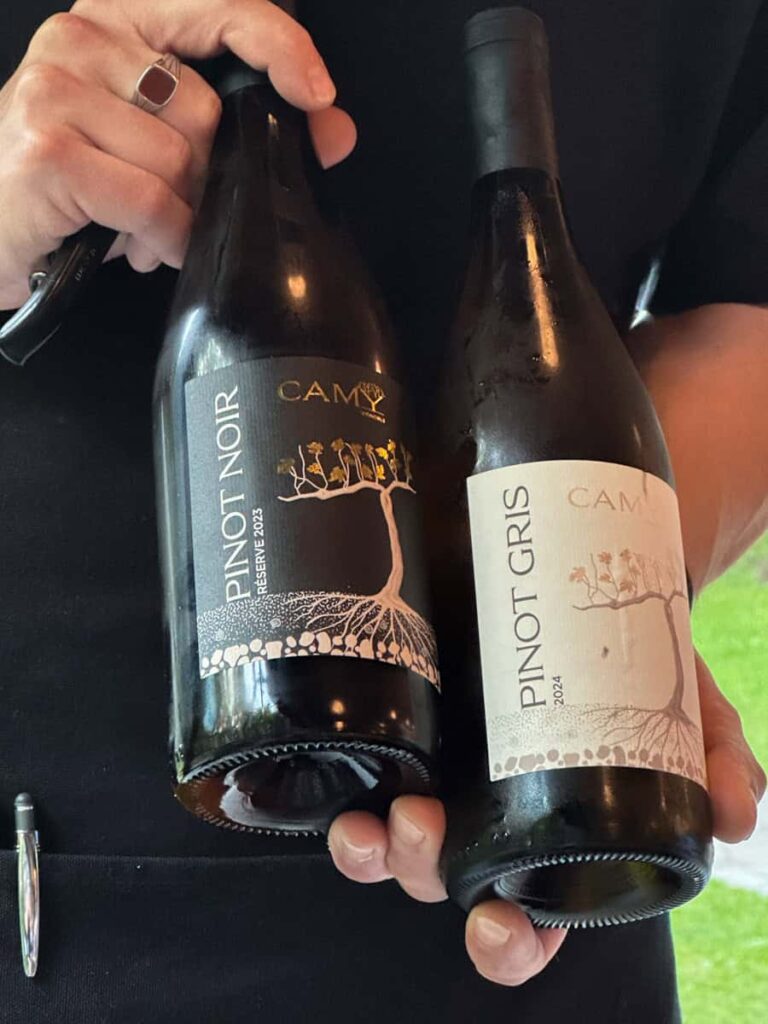
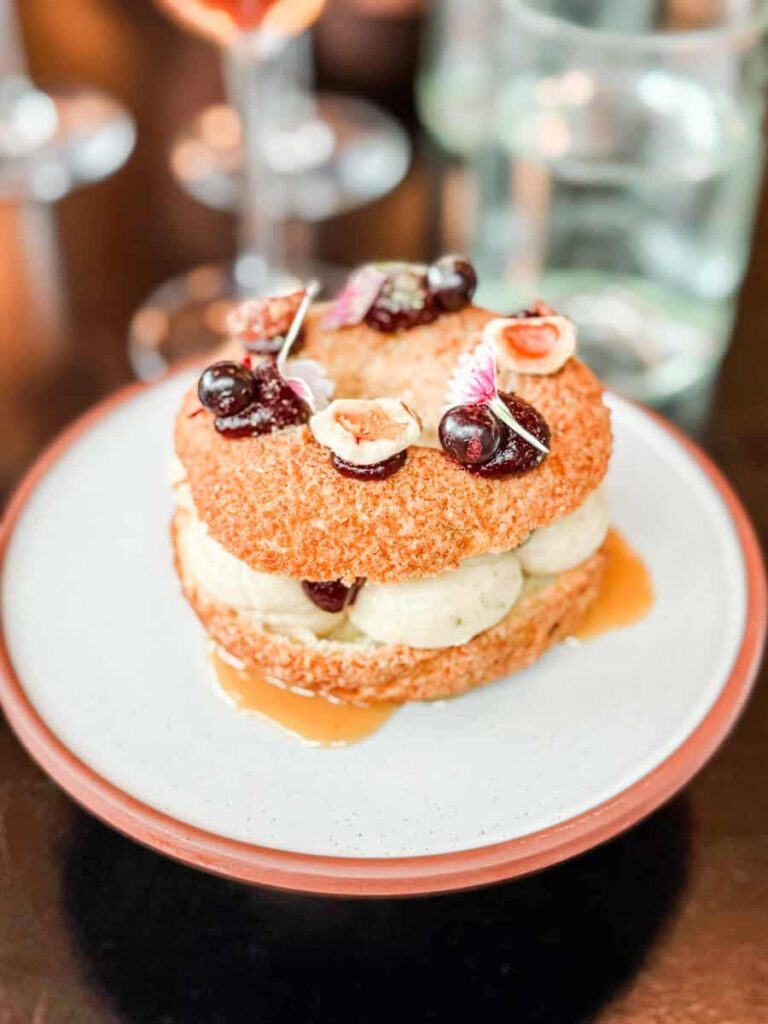
Nord, 641 Chemin de la Montagne, Mont-Saint-Hilaire, QC
Sucrerie de la Montagne
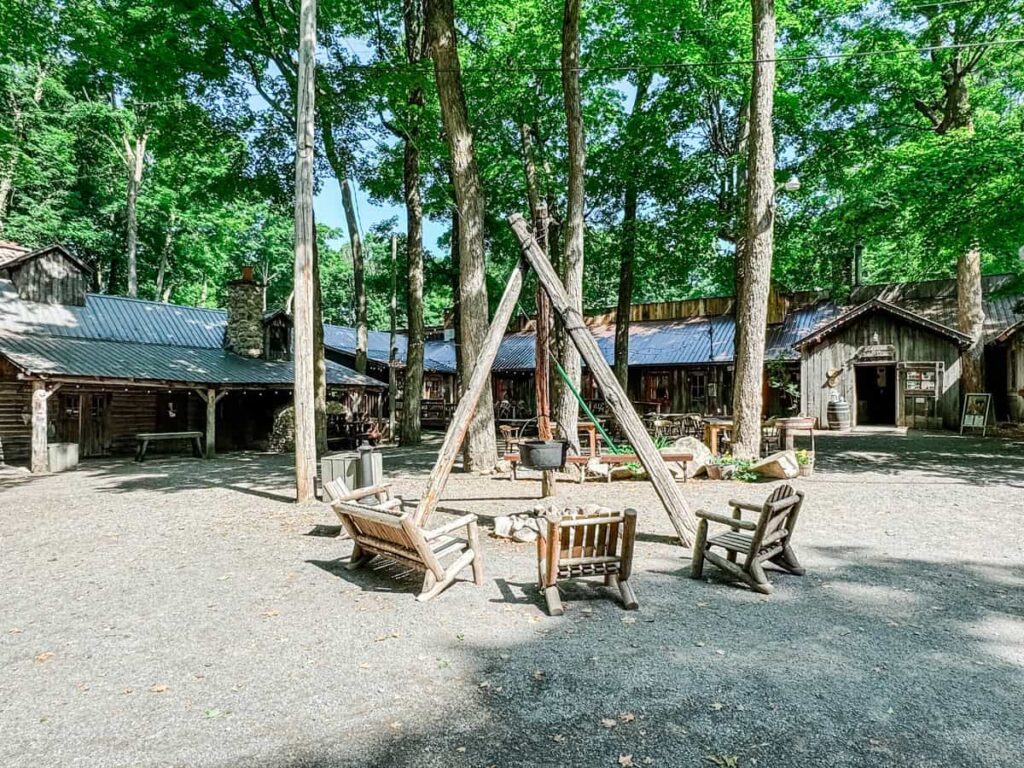
If you’re looking for the full sugar shack experience, rustic log cabins, maple-infused food, and traditional production methods, this is the place.
Set in a maple forest, Sucrerie de la Montagne blends old-school techniques with a festive, welcoming vibe. There’s live folk music, hearty family-style meals, and even Caribou wine (a sweet red mixed with spirits and maple syrup).
Our tour was led by Stefan, the son (and spitting image) of founder Pierre. He walked us through the syrup-making process they still use with metal buckets. He also shared stories of the family’s history and how they came to host thousands of visitors each spring, including Anthony Bourdain.
The meal was served in the dining hall by the giant fireplace, and felt like stepping back in time. Platters of maple-smoked ham, sausages, omelet soufflé, meat pie, and mashed potatoes kept arriving at the table. Afterward, we were invited up to the stage for a crash course in playing the spoons. And the sweet finish was a slice of sugar pie, a fluffy stack of pancakes, and plenty of maple syrup to go around.
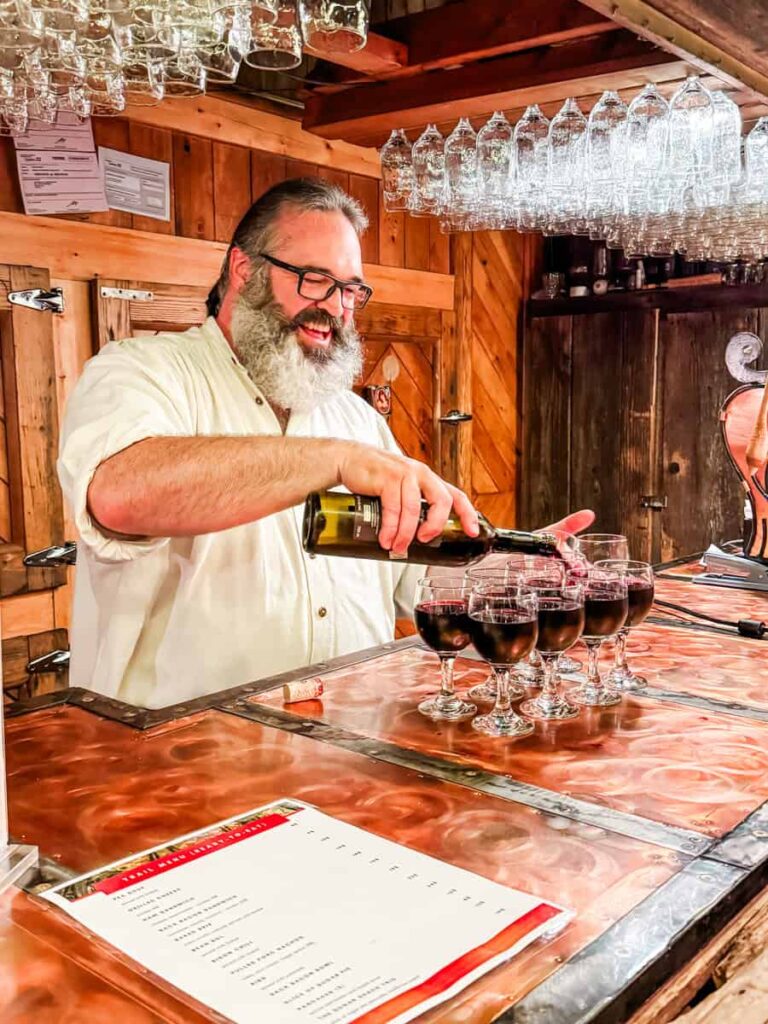
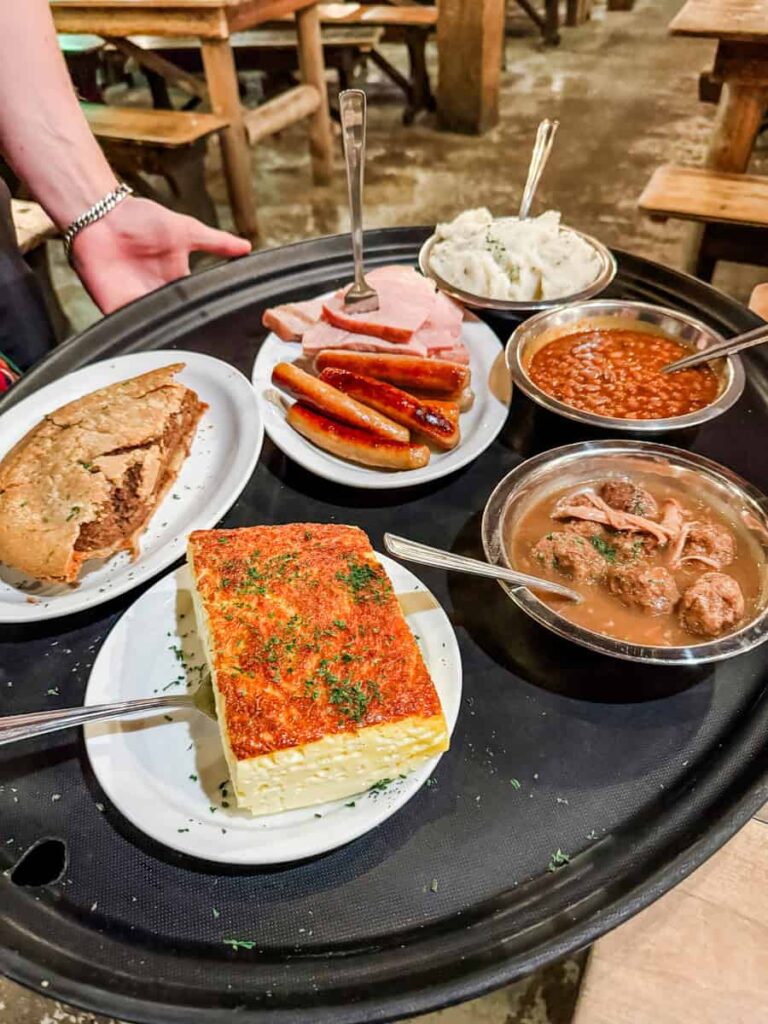
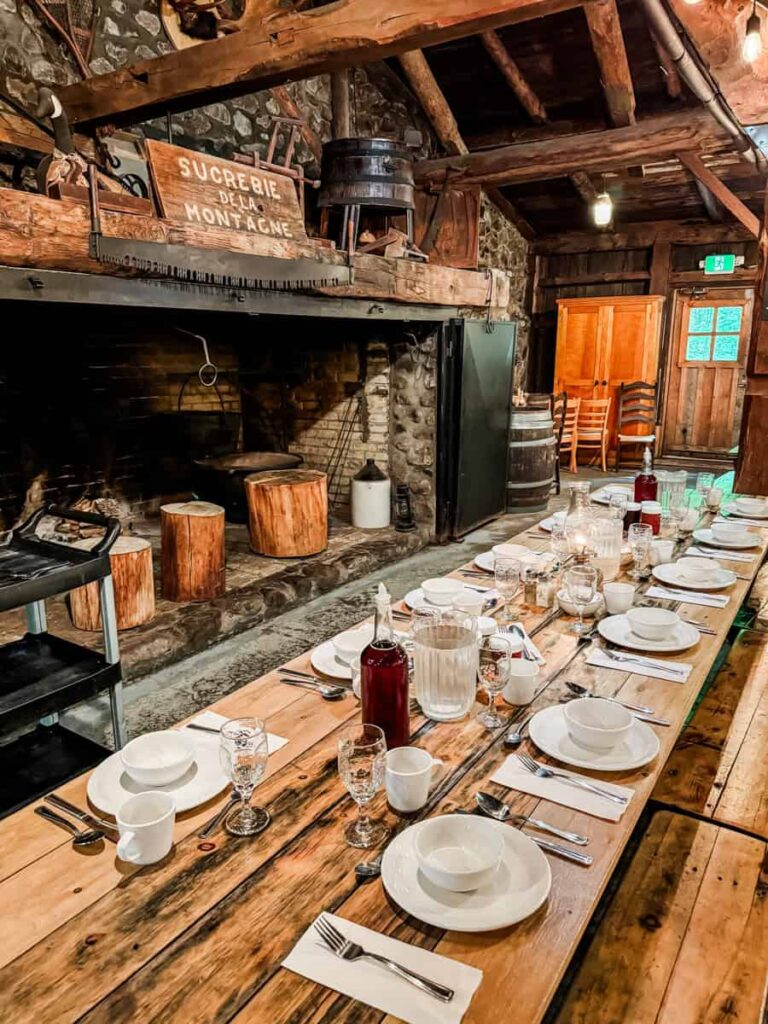
Sucrerie de la Montagne, 300 Ch. Saint-Georges, Rigaud, QC
Other Things to Do in Montérégie
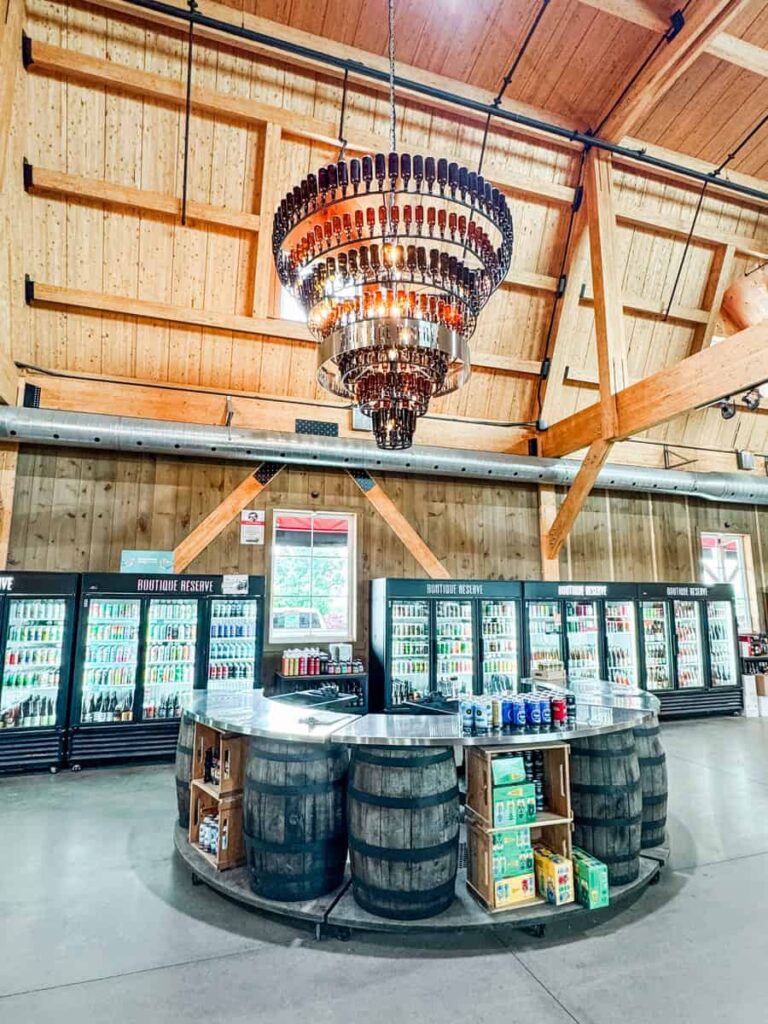
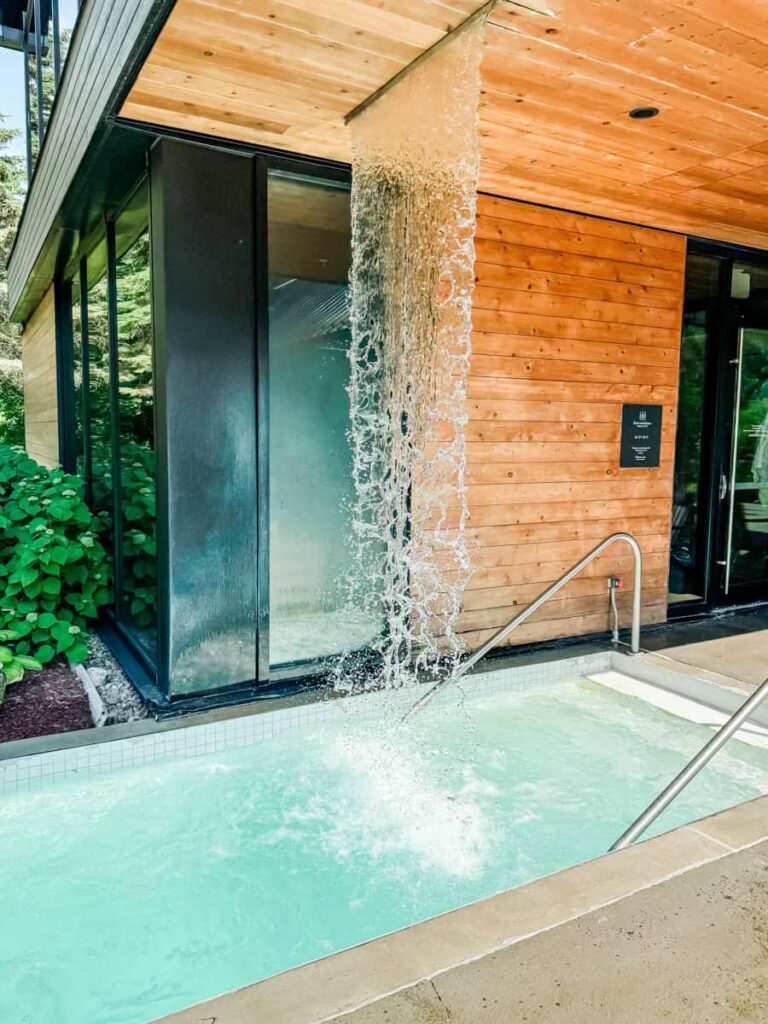
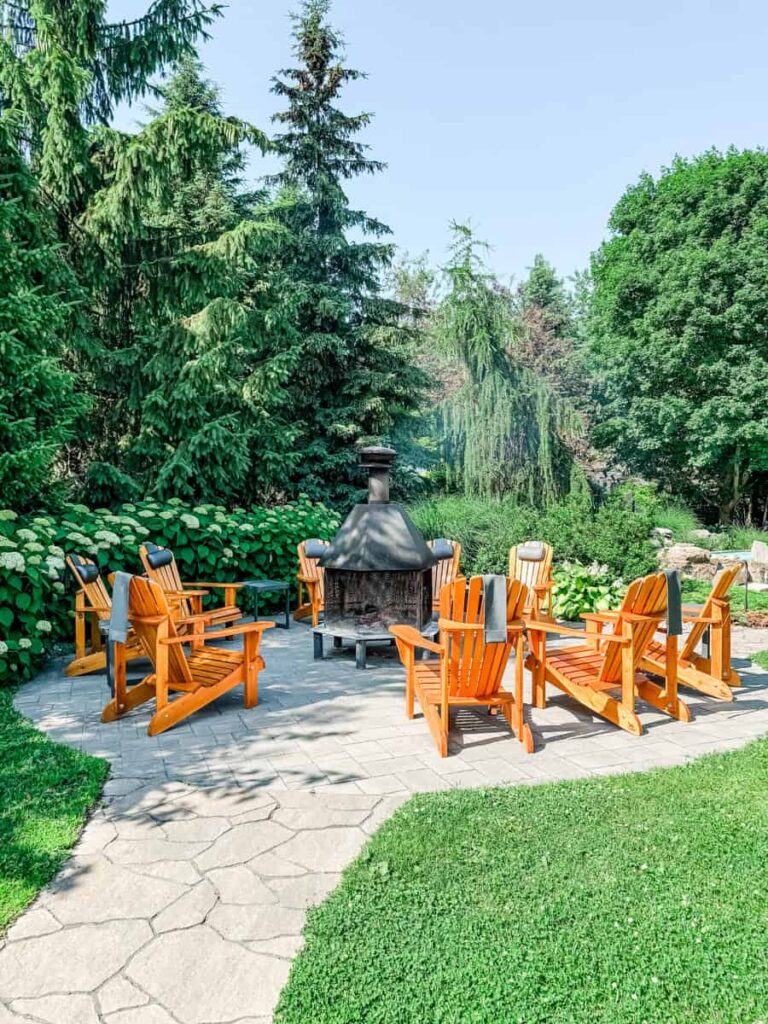
Just a short drive from Montréal, Montérégie offers more than just tastings. It’s a region where wellness, nature, and local flavor come together, making it easy to build a full itinerary around food, drink, and relaxation.
- Taste Your Way Through Ferme Guyon: If you don’t have time to visit all the producers in the region, this is the place to go. Ferme Guyon brings together local wines, ciders, cheeses, meats, and more, with in-store tastings available. We picked up picnic supplies here before heading to a ciderie. While you’re there, take a stroll through the butterfly greenhouse and stop by the educational farm to visit the animals.
- Relax at Strøm Spa Nordique Mont-Saint-Hilaire: Built into the forest of the Gault Nature Reserve, this thermal spa was one of the most peaceful places I’ve visited. From saunas and hot tubs to a relaxation room with floor-to-ceiling windows, it’s easy to spend hours here. Just bring a swimsuit, flip-flops, and water bottle. The locker rooms are stocked with everything you’ll need post-soak.
- Explore the Cider Route: Montérégie is known for its award-winning ciders, and the Route des Cidres links several producers offering everything from traditional to ice cider.
- Cycle the Scenic Countryside: Montérégie is a top destination for cyclo-tourism in Québec, with more than 600 km of bike trails. Ride past vineyards, orchards, and riverfront towns with plenty of delicious stops along the way.
Where to Stay in Montérégie
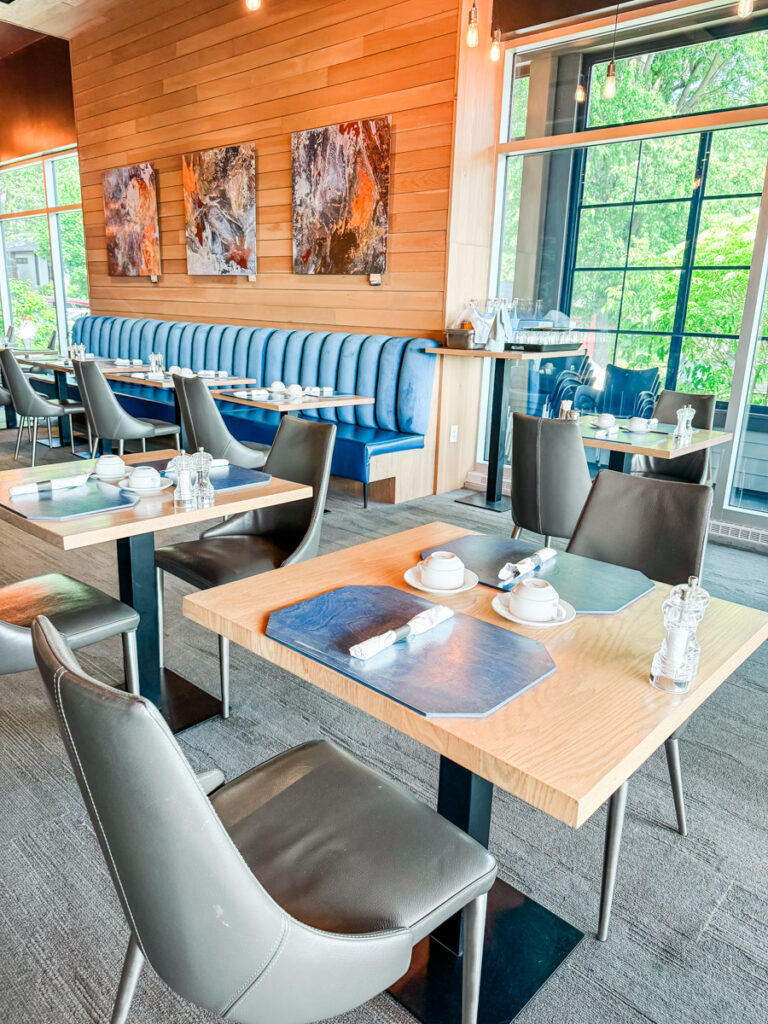
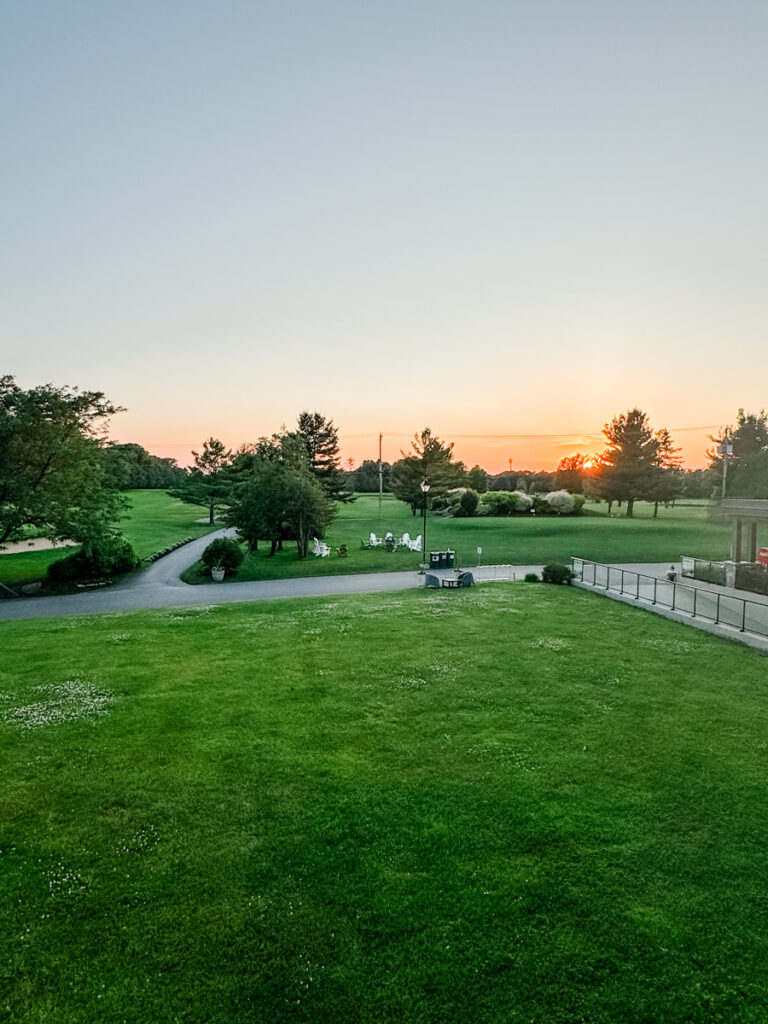
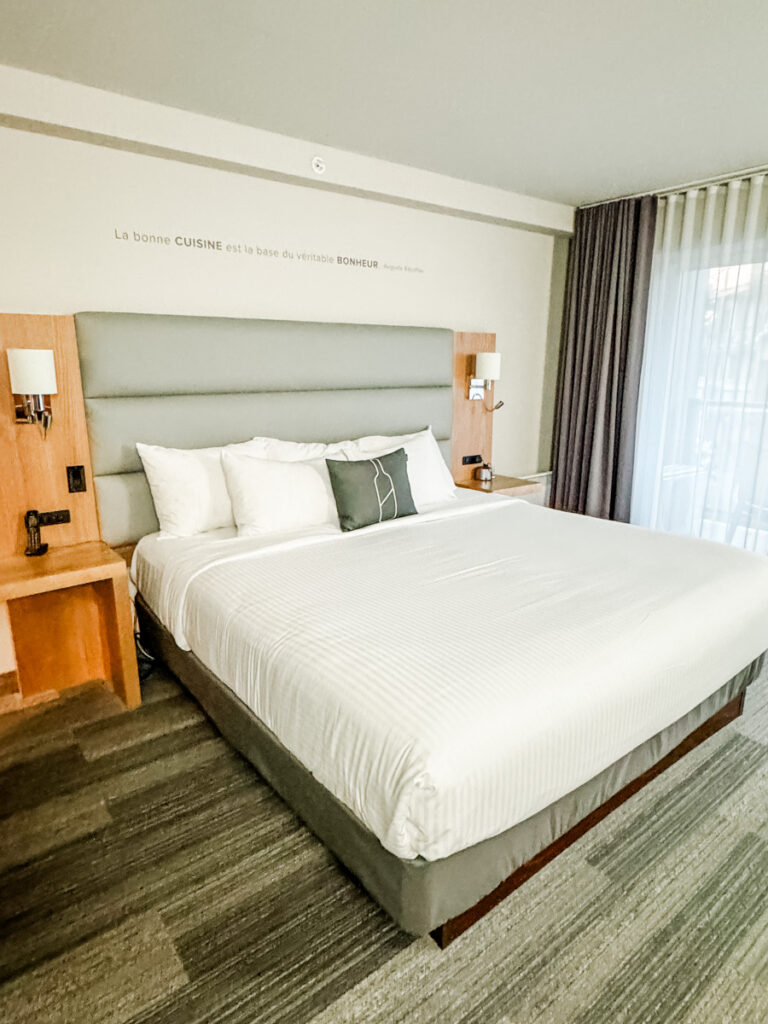
From the northern edge of Montérégie to the shores of Lake Champlain, this region has ideal spots to stay for easy access to wineries, cideries, restaurants, and local producers.
Hôtel Rive-Gauche puts you close to both the Richelieu Valley countryside and the quaint downtown of Beloeil. It’s also home to Le Coureur des Bois, one of Québec’s most acclaimed restaurants with a Wine Spectator Grand Award. My room included a balcony, small dining area, and lounge chairs, perfect for relaxing after a day exploring.
La Cache du Lac Champlain offers a more resort-like stay by the lake. My spacious room overlooked the golf course, and I watched the sunset on the balcony with a glass of local sparkling cider. Their Noah Spa includes Canada’s only “eaunergic” pool, with massaging hydrotherapy. Plus, there’s easy lake access, trails, and seasonal activities like kayaking and paddleboarding.
🏨 Book the Hôtel Rive-Gauche
🏨 Book the La Cache du Lac Champlain
Centre-du-Québec
While Centre-du-Québec might not be the first region people think of for wine and food, it turned out to be one of the most memorable parts of the trip.
From a vineyard pouring cool-climate wines with local cheese made in a former church, to a farm-to-table dinner that felt like a hidden gem, this region offered plenty of heart and flavor. It’s a quieter destination, but one that delivers for travelers looking to slow down and discover something different.
Vignoble les Côtes du Gavet
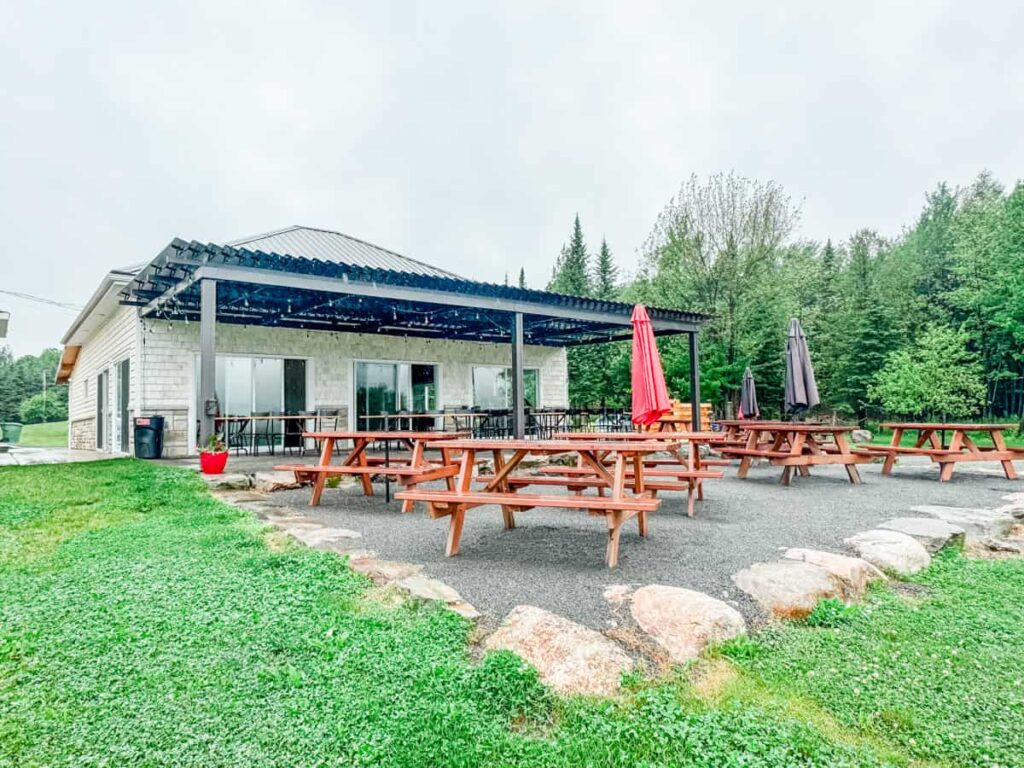
Les Côtes du Gavet is a small, family-run winery in Tingwick. If you’re looking for great sparkling wine and a relaxed, personal tasting, this spot should be on your list.
The Marchand family took over this 25-year-old vineyard in 2023. With around 6,000 vines, they produce a mix of vinifera and hybrid varieties like Frontenac Blanc, Louise Swenson, and Crimson Pearl. Some of their wines have even won medals at the Coupe des Nations.
We visited on a drizzly day, so we sat inside the tasting room. But I still enjoyed views of the misty vineyard and countryside. On a nicer day, the lawn would be the perfect picnic spot since outside food is welcome. They also host wood-fired pizza nights on summer weekends.
The guided tasting was relaxed and informative. I liked their traditional method sparkling and the still white, paired with cheeses from nearby La Fromagerie du Presbytère. After the tasting, we got a look behind the scenes with a short tour of the winemaking facility.
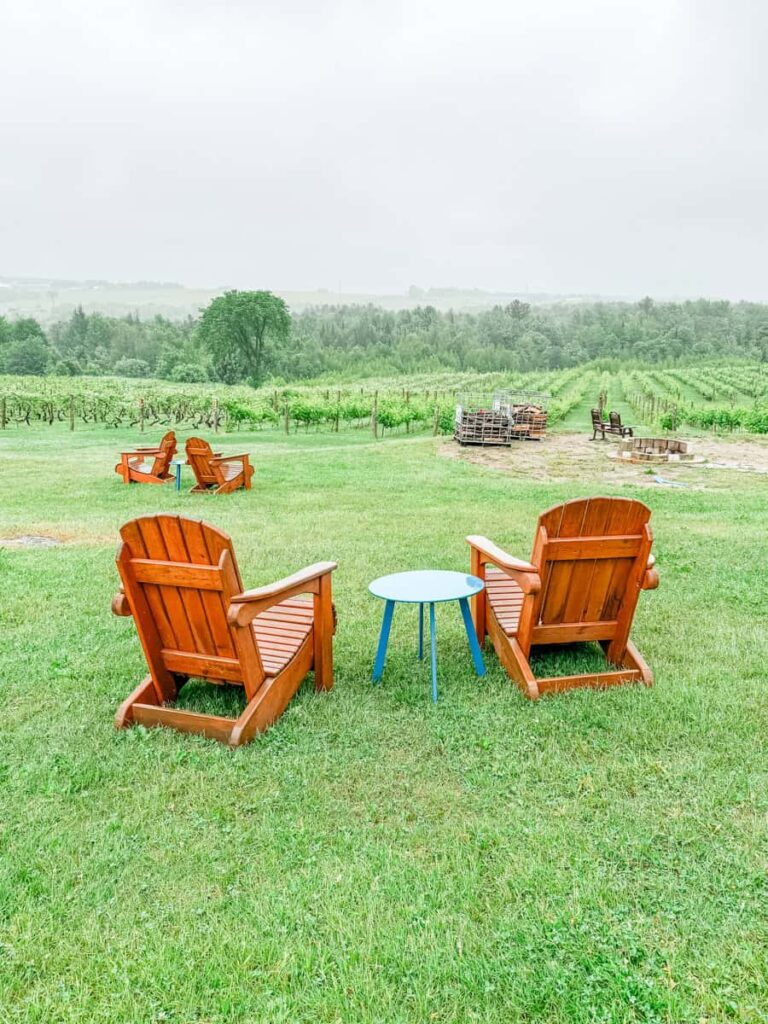
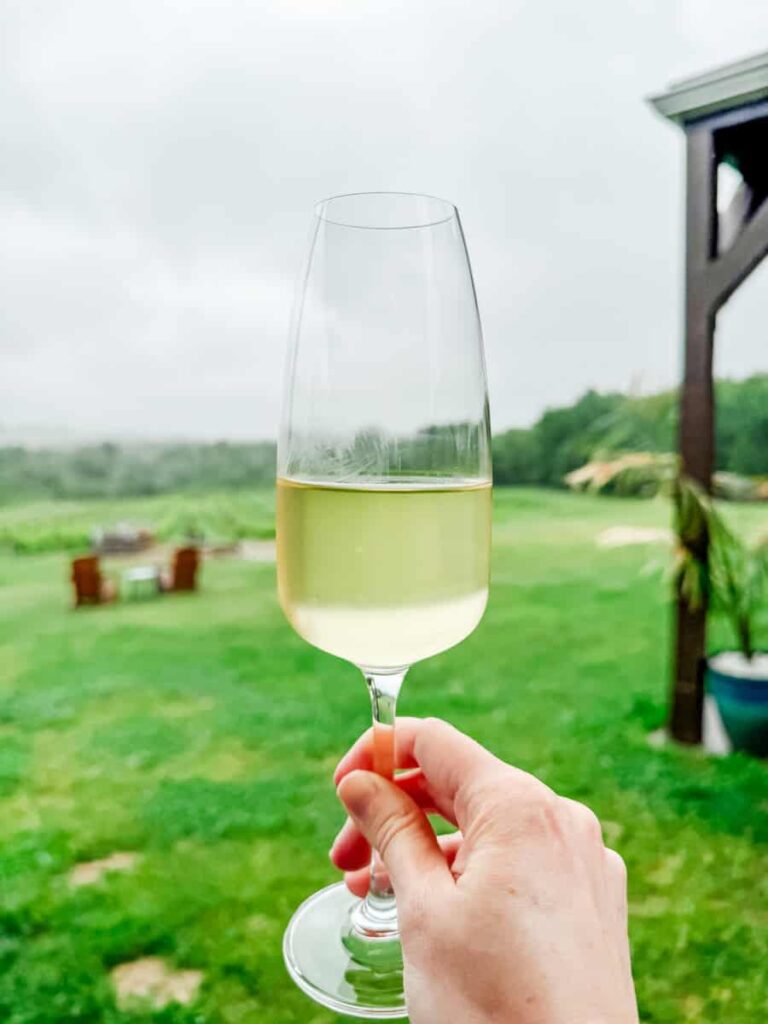
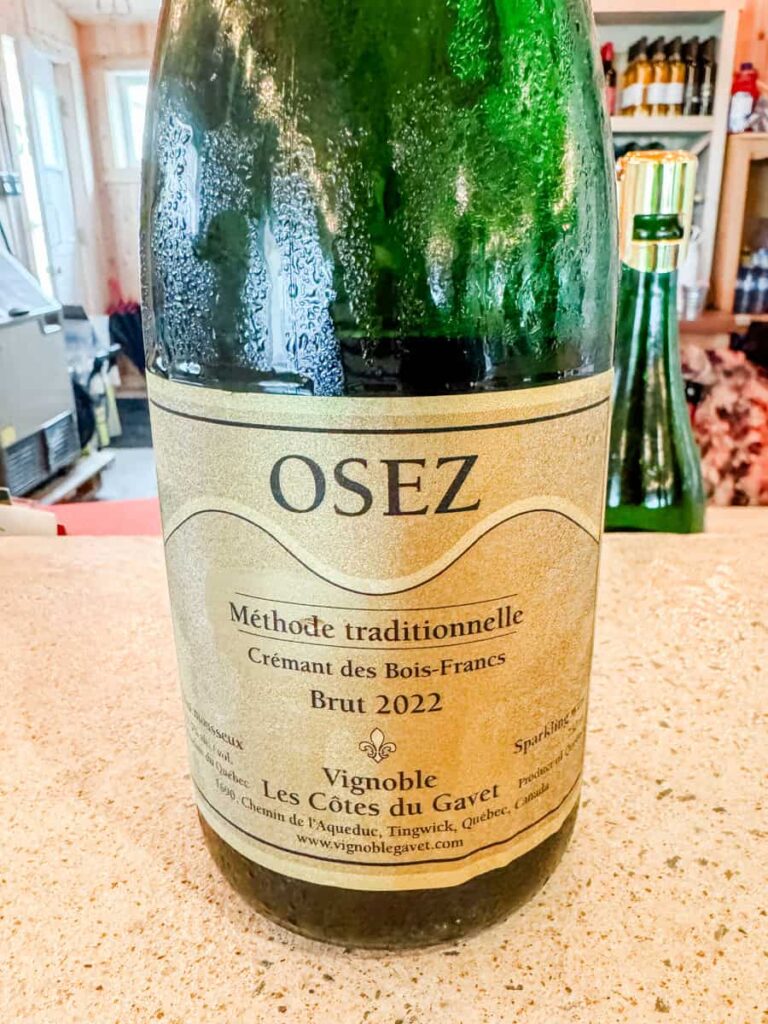
Les Côtes du Gavet, 1690 Chemin de l’Aqueduc, Tingwick, QC
Au Pâturage
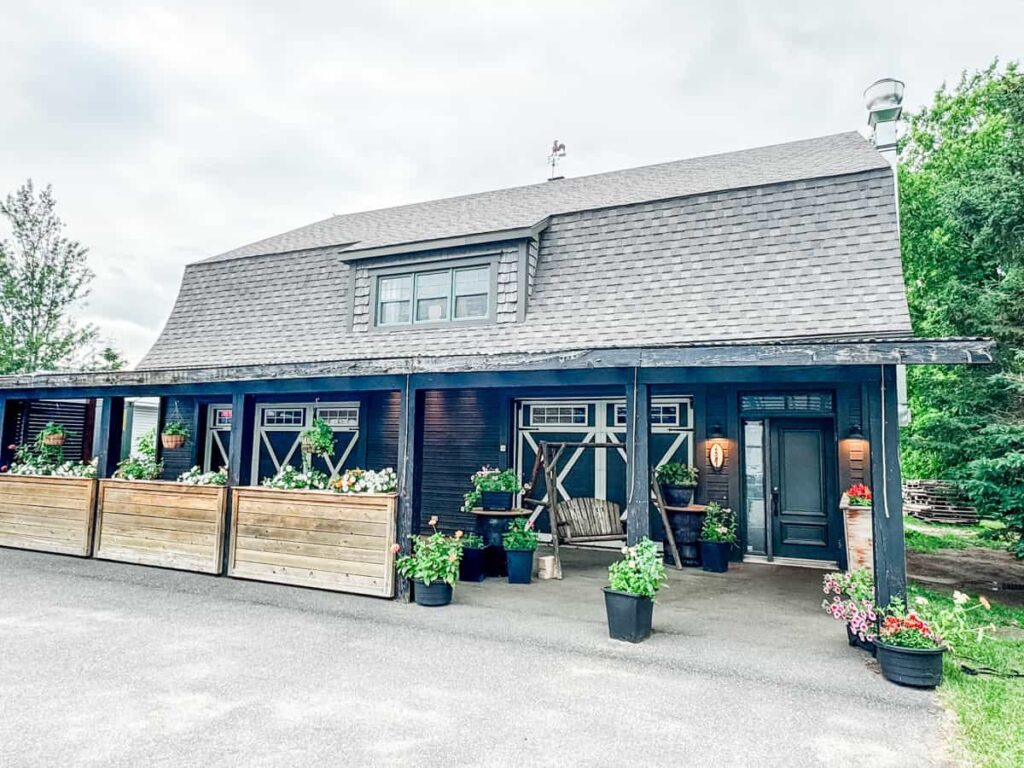
If you’re into seasonal tasting menus, garden-grown produce, and wine pairings, Au Pâturage is a must.
Set in the tiny village of Sainte-Perpétue, this farm-to-table spot is run by chef Chloé Ouellet, who grows most of the veggies herself in the three-acre garden behind the restaurant. She’s also a former contestant on Les Chefs!, Québec’s top cooking competition show.
I started with a cocktail and took in the view from the patio, which overlooks the lawn and gardens. The five-course meal ended up being one of my favorites of the trip.
Standouts included scallops with seaweed and radish, rabbit with mushrooms, and asparagus paired with a bright Czech rosé made from Blaufränkisch. Wine pairings were a mix of local and international, with some unexpected and delicious finds. Definitely worth planning a night around if you’re in the area.
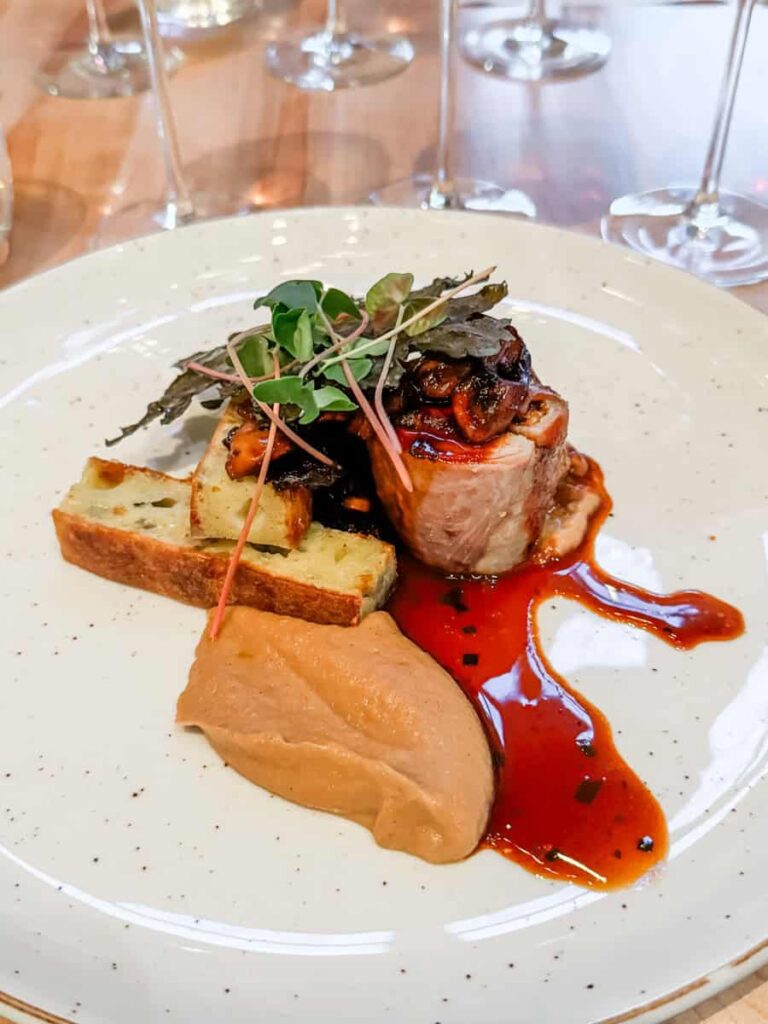
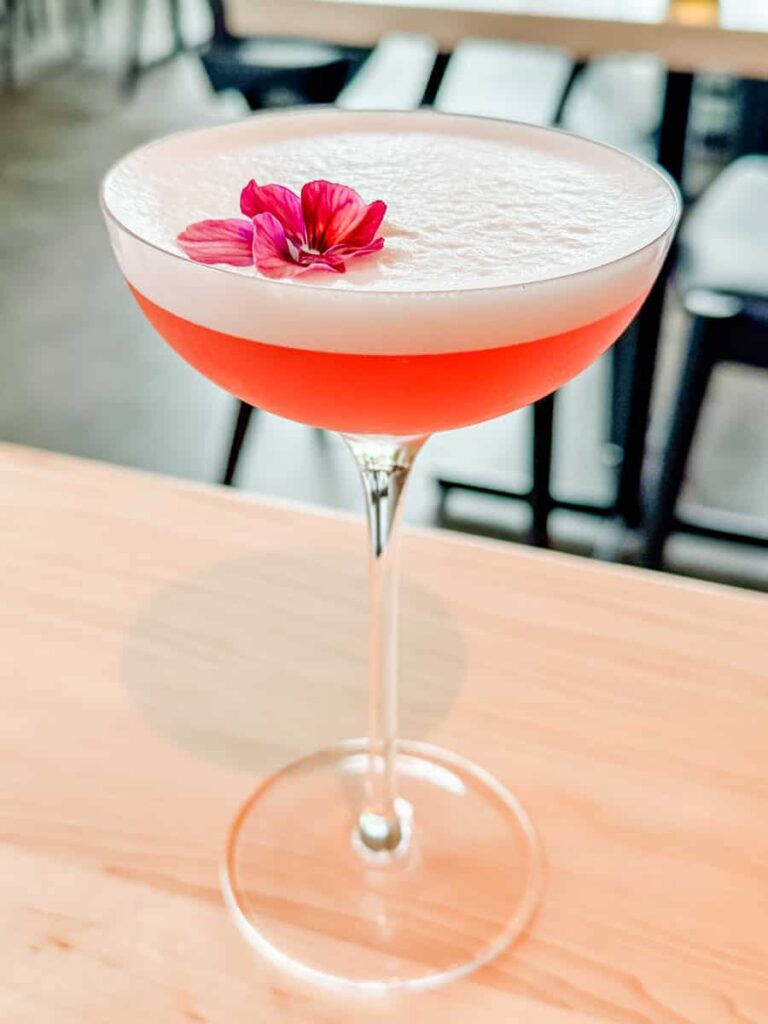
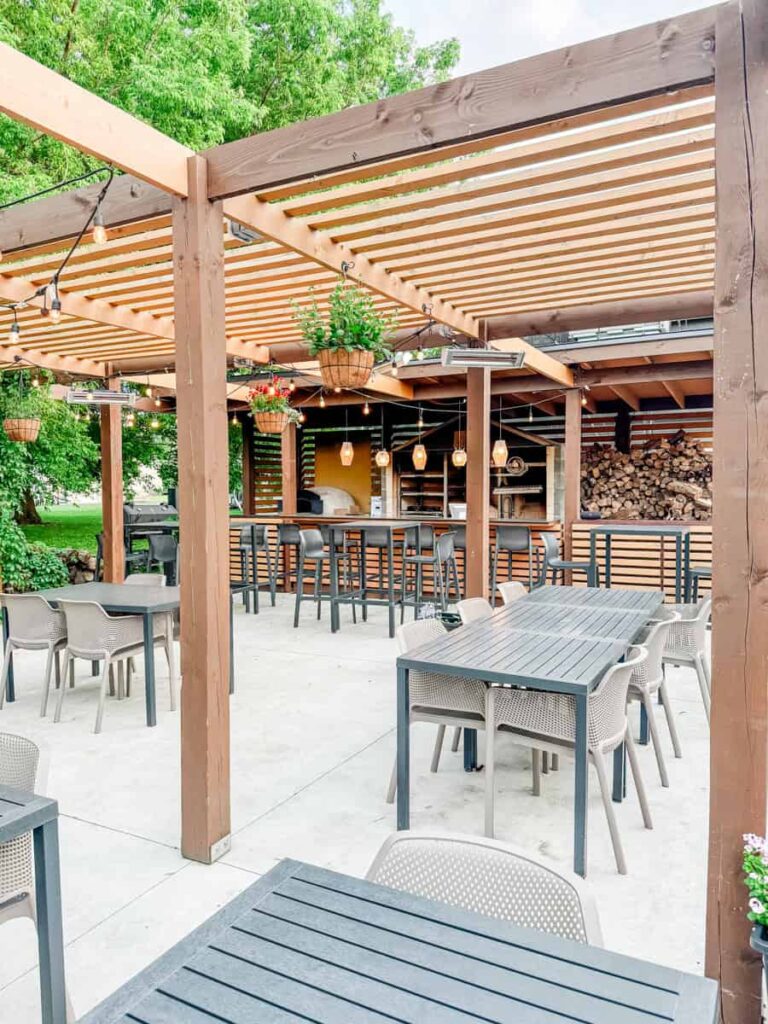
Au Pâturage, 2581 Rang Saint-Joseph, Sainte-Perpétue, QC
Other Things to Do in Centre-du-Québec
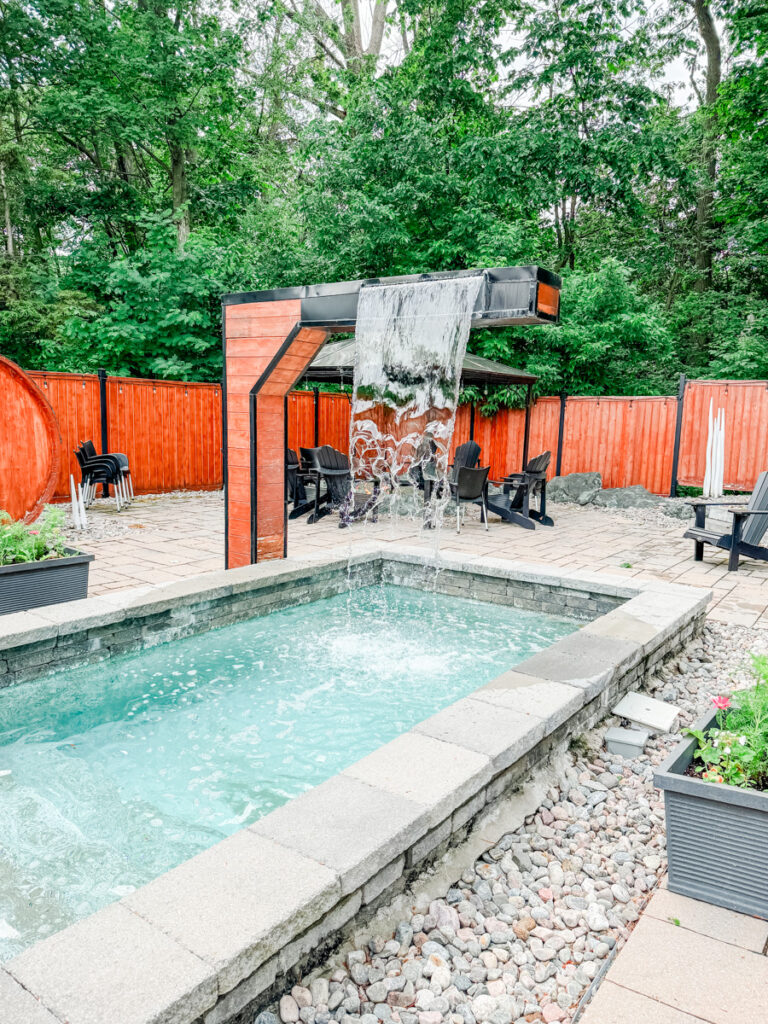
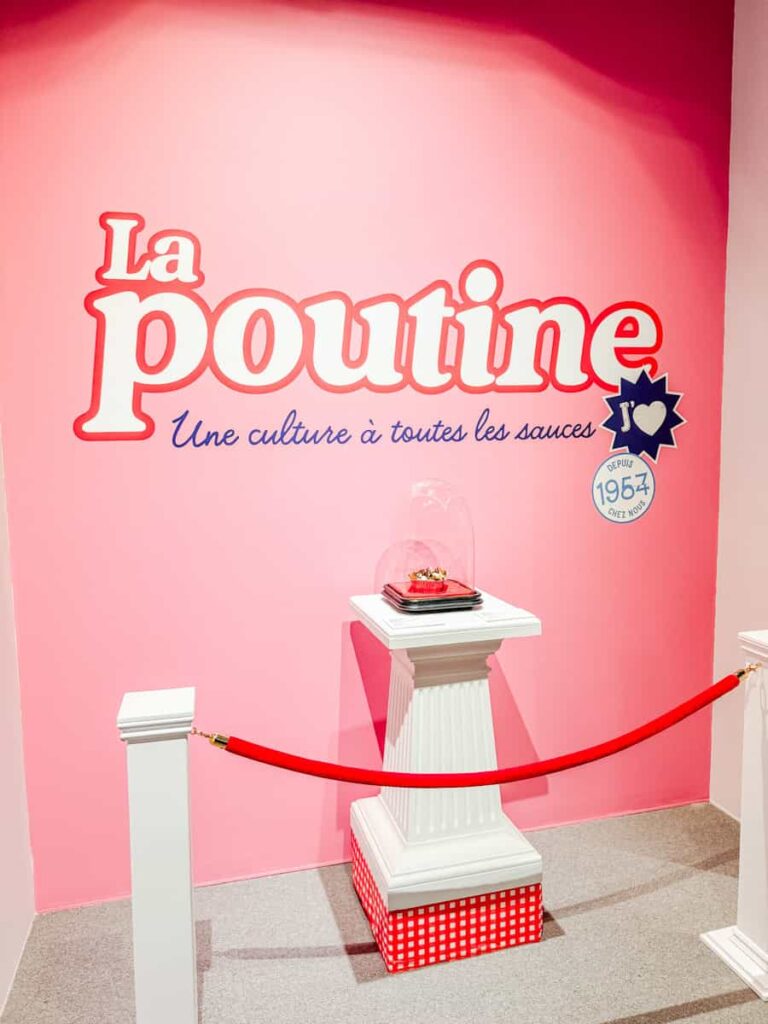
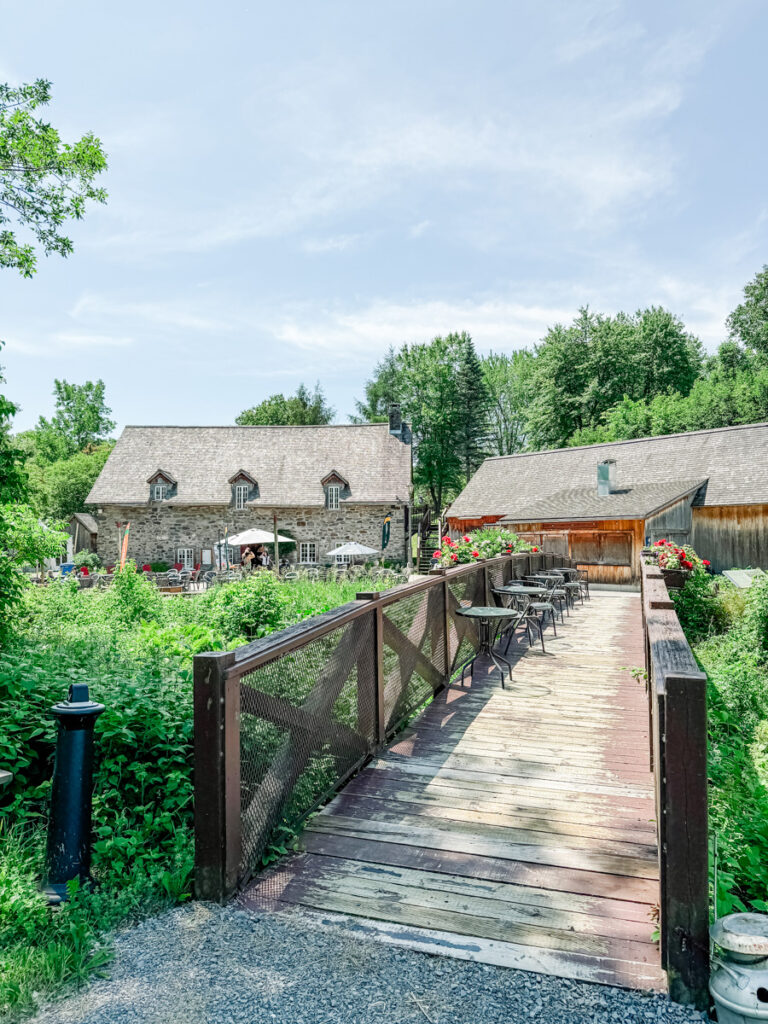
This region is full of local flavor, cultural stops, and scenic nature spots, perfect for pairing with a winery visit.
- Visit Moulin Michel: One of the last working flour mills in Québec, Moulin Michel offers a fascinating glimpse into the past. I loved learning about the traditional buckwheat milling process, then grabbing lunch made with bread crafted from their stone-ground flour. They also host festivals, concerts, and seasonal events.
- Explore the Musée des Cultures du Monde: This cultural museum in Nicolet hosts rotating exhibits that dig into Québec’s identity. When I visited, it was all about poutine, complete with interactive displays, regional variations, and a very important debate over who really invented it.
- Follow the Flavour Tour: With stops ranging from cheese shops and sugar shacks to craft distilleries, the Centre-du-Québec Flavour Tour is a fun way to sample the region’s specialties.
- Unwind at Hôtel Montfort’s Spa: After a day of exploring, the spa at Hôtel Montfort is the place to recharge. I hopped between the hot tubs, sauna, and cold plunge (well, almost), and could have easily spent all afternoon lounging by the firepit.
- Walk the Boardwalk at Parc écomaritime de l’Anse-du-Port: This accessible wooden boardwalk winds through forest and wetland habitats, with rest stops and observation decks along the way. A 12-meter-high tower offers views of the St. Lawrence River and the Lac-Saint-Pierre Biosphere Reserve.
Where to Stay in Centre-du-Québec
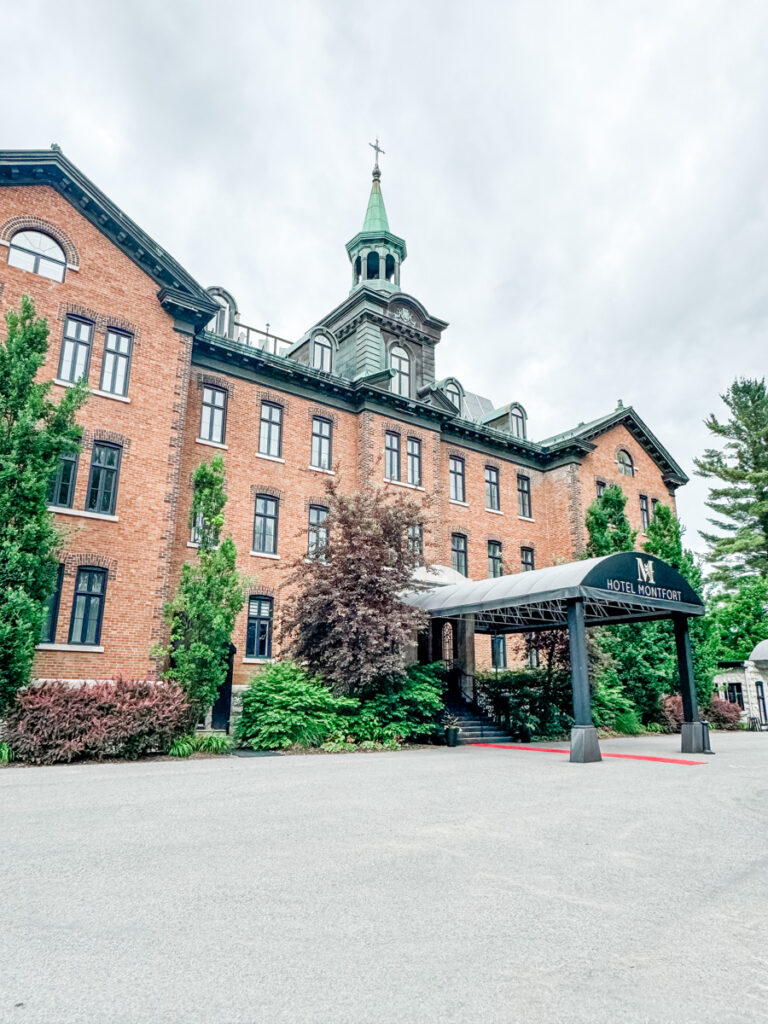
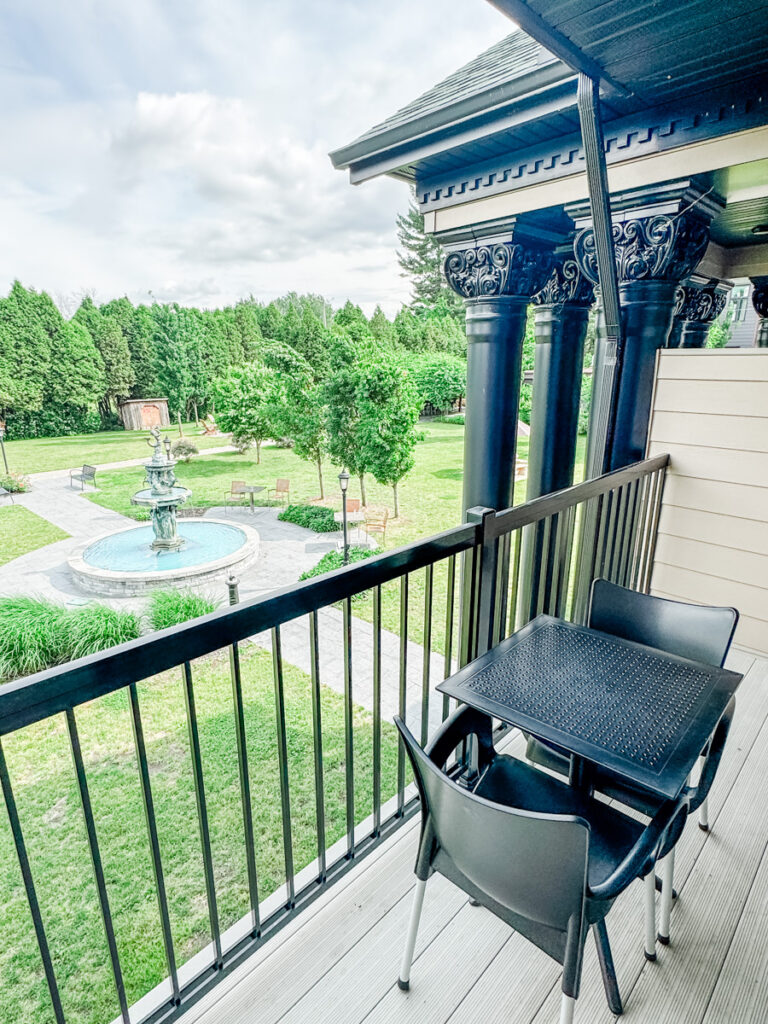
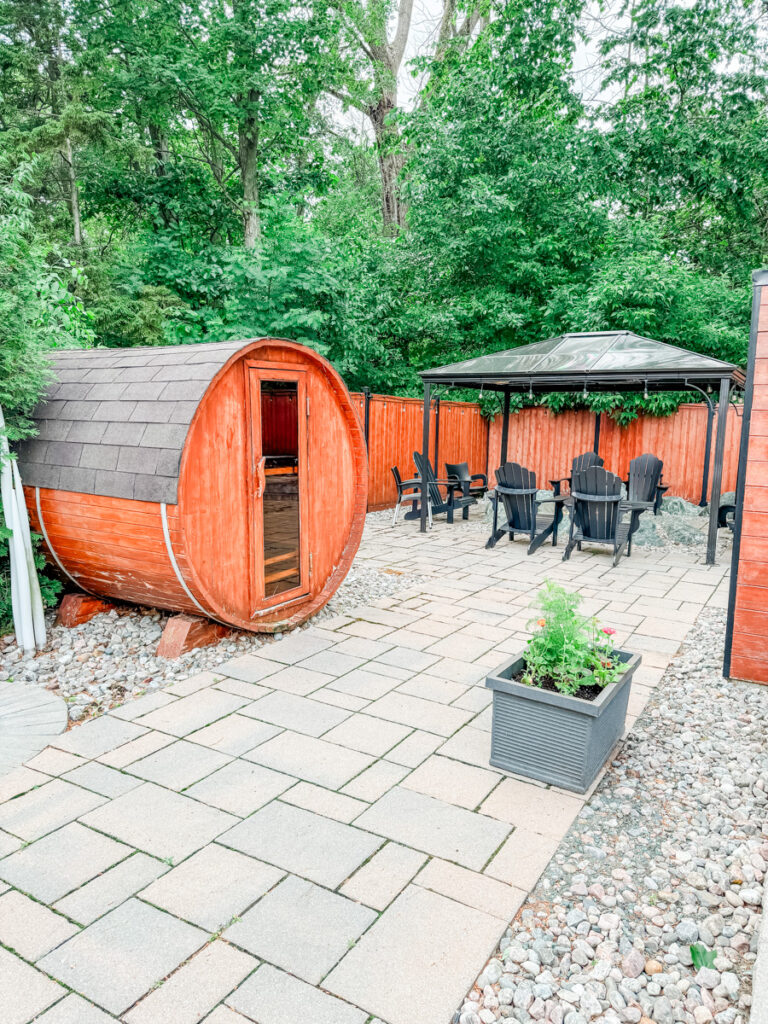
Hôtel Montfort Nicolet blends peaceful surroundings with plenty of on-site perks, making it a great base for exploring the Centre-du-Québec region. Set on a property that was once home to the Montfort Fathers, the hotel has modern rooms, a wellness center with thermal spa access, and a bistronomic restaurant.
My room had a jetted tub and a balcony that looked out over the property. There was even a fountain just below, which made for a relaxing spot to enjoy a beverage. The breakfast buffet had plenty of options. And there’s also an indoor pool and massage services if you want to add some downtime to your trip.
🏨 Book the Hôtel Montfort
FAQs About Wine Tasting in Southern Québec
The soils here come from an ancient seabed, thanks to the long-gone Champlain Sea. That, plus the warm sunny days and cooling influence of Lake Champlain and the Richelieu River, makes this a solid spot for growing wine grapes.
Most Québec wineries focus on cold-hardy hybrids like Marquette, Frontenac, Seyval, and Louise Swenson that can survive the cold winters and still make good wine. But you’ll also see some vinifera varieties, like Riesling, Chardonnay, Pinot Gris, and Pinot Noir.
You’ll find crisp whites, bright rosés, and lots of traditional method sparkling wines. Reds are usually lighter and more acidic, but winemakers are experimenting with oak and blends to add depth. Some also make late-harvest or ice wines. And since this is apple country, you’ll often see cider on the tasting list. A few spots make maple-based drinks too.
Late spring through fall is ideal for wine tasting and outdoor activities. September and October are especially scenic with harvest season and fall foliage. Winter is great for spa visits, skiing, and festive events like Christmas markets.
French is the primary language in Québec, but many winery and hotel staff speak some English, especially in tourist-friendly areas. A few basic phrases or a translation app can go a long way.
A car is the most convenient way to explore the regions and reach wineries, especially in more rural areas. However, some wineries are near towns or bike routes. Guided tours are also available in select areas.
Most wineries are open from spring through fall. Some stay open year-round, especially those with indoor facilities or shops. Always check hours and make reservations when possible.
They’re generally pretty affordable at $10-$20 CAD. Some wineries waive the fee with a bottle purchase.
Keep Exploring Québec’s Wine Country
Southern Québec is packed with wine routes, farm-to-table dining, and relaxing spas surrounded by vineyards. But if you’re heading north, don’t miss the wineries near Québec City on Île d’Orléans. You can sip crisp whites and ice wine with river views, snack on lobster rolls, and taste the island’s delicious blackcurrant products.
Check out More Wine Destinations
- A Local’s Guide to the 10 Best New Hampshire Wineries
- 5 Best Southern Maine Wineries & Wine Bars
- The Best Cape Cod, Massachusetts Wineries
- A Local’s Guide to the Best Wineries in Newport, RI
- 8 Best Keuka Lake Wineries in the Finger Lakes, NY
- 10 Best Seneca Lake Wineries in the Finger Lakes, NY
- A Perfect Day at Canandaigua Lake Wineries
- The Best North Fork Long Island Wineries
- Where to Go Wine Tasting in New York’s Hudson Valley

